Now I'll write the article following the format requirements, making sure each section is 100-120 words, with the introduction being max 100 words and conclusion max 100 words.A boot room serves as the essential transitional space between the outdoors and your home's interior, providing dedicated storage for muddy boots, wet coats, and outdoor gear. Whether you have a small entrance lobby or porch, a basic utility, a garage that's crying out to be converted into a mudroom, or the potential for an outdoor boot room area, creating a dedicated mudroom that meets both your needs and budget is possible. Modern boot rooms combine practical functionality with stylish design elements, helping to keep dirt and clutter away from your main living spaces while adding value to your property. From traditional country house designs to contemporary minimalist solutions, these 20 boot room ideas will inspire you to create an organized, welcoming entrance space that works perfectly for your lifestyle and available space.
1. Boot Room Traditional Built-In Storage Wall
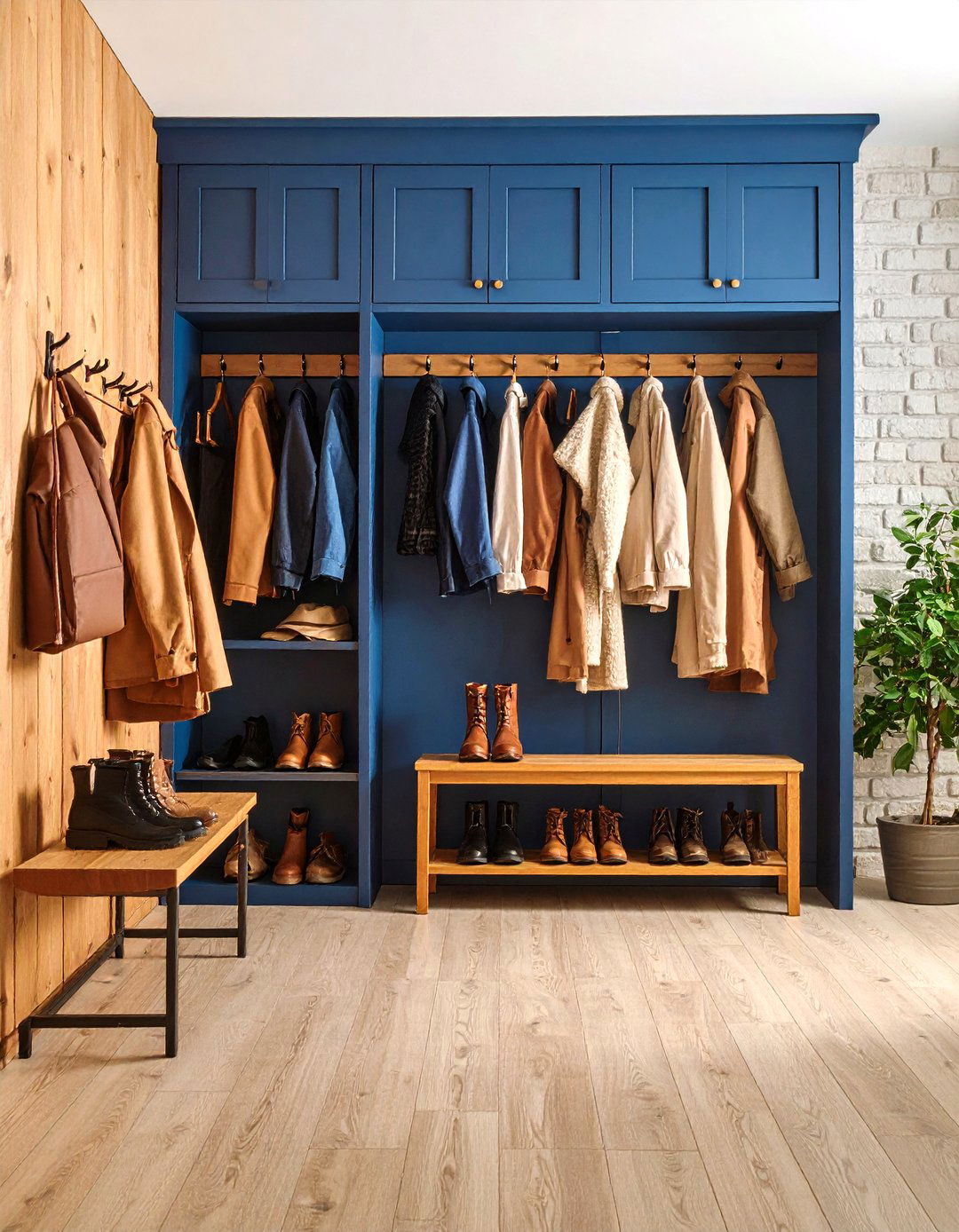
A traditional built-in boot room storage wall maximizes every inch of available space with floor-to-ceiling cabinetry designed specifically for outdoor gear organization. In this concept, we love the built-in floor-to-ceiling cabinetry painted in a stunning heritage blue. It's a striking yet practical design, especially paired with exposed brick, wood panelling, a storage bench, and plenty of handy coat hooks. These custom solutions typically feature a combination of closed cupboards for storing seasonal items, open cubbies for daily-use boots and shoes, and multiple hanging spaces at varying heights to accommodate both adult and children's coats. Having made-to-measure cabinets built to fit your space – and your storage needs – is the best way to achieve boot room bliss. The traditional approach often incorporates classic materials like painted wood paneling and sturdy hardware that can withstand heavy daily use while maintaining an elegant, timeless appearance.
2. Boot Room Under-Stair Conversion
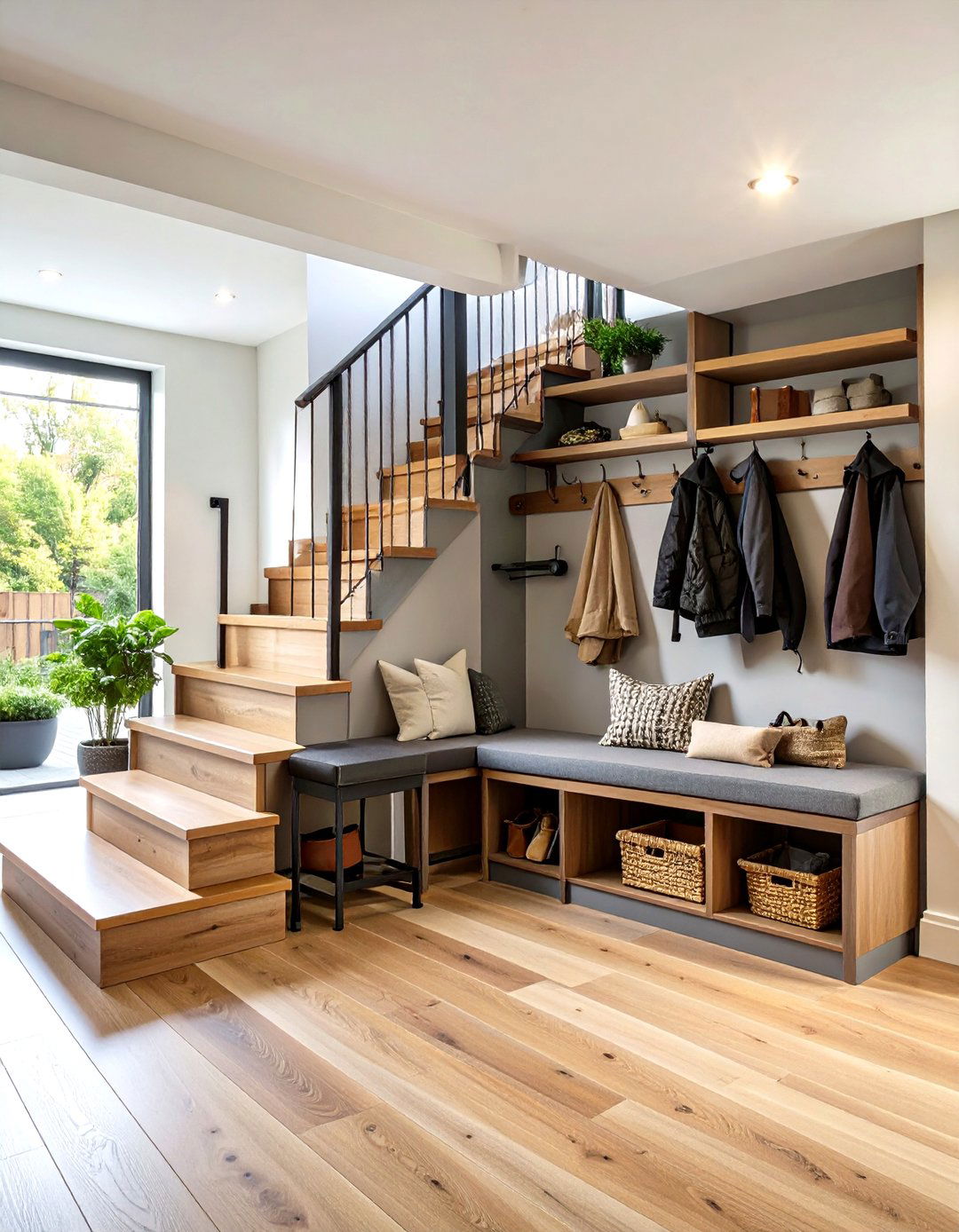
Converting the space beneath your staircase into a boot room creates a clever mini storage solution that maximizes unused areas in your home. Even when space is at a premium, smart storage solutions will help you to make the most of the square footage available. Under a staircase, where head height is limited, a bench with built-in storage is the idea option. This boot room design typically features low-level seating with lift-up storage compartments underneath, wall-mounted hooks positioned at accessible heights, and narrow shelving that follows the stair's diagonal line. Think of it as a mini decompression zone, where you can kick off your shoes and the stresses of the day before immersing yourself back into family life. The awkward triangular space can accommodate shoe storage cubbies, umbrella stands, and coat hanging areas while maintaining the home's traffic flow. Consider adding lighting to brighten this naturally darker space.
3. Boot Room Scandinavian Style with Light Wood Paneling
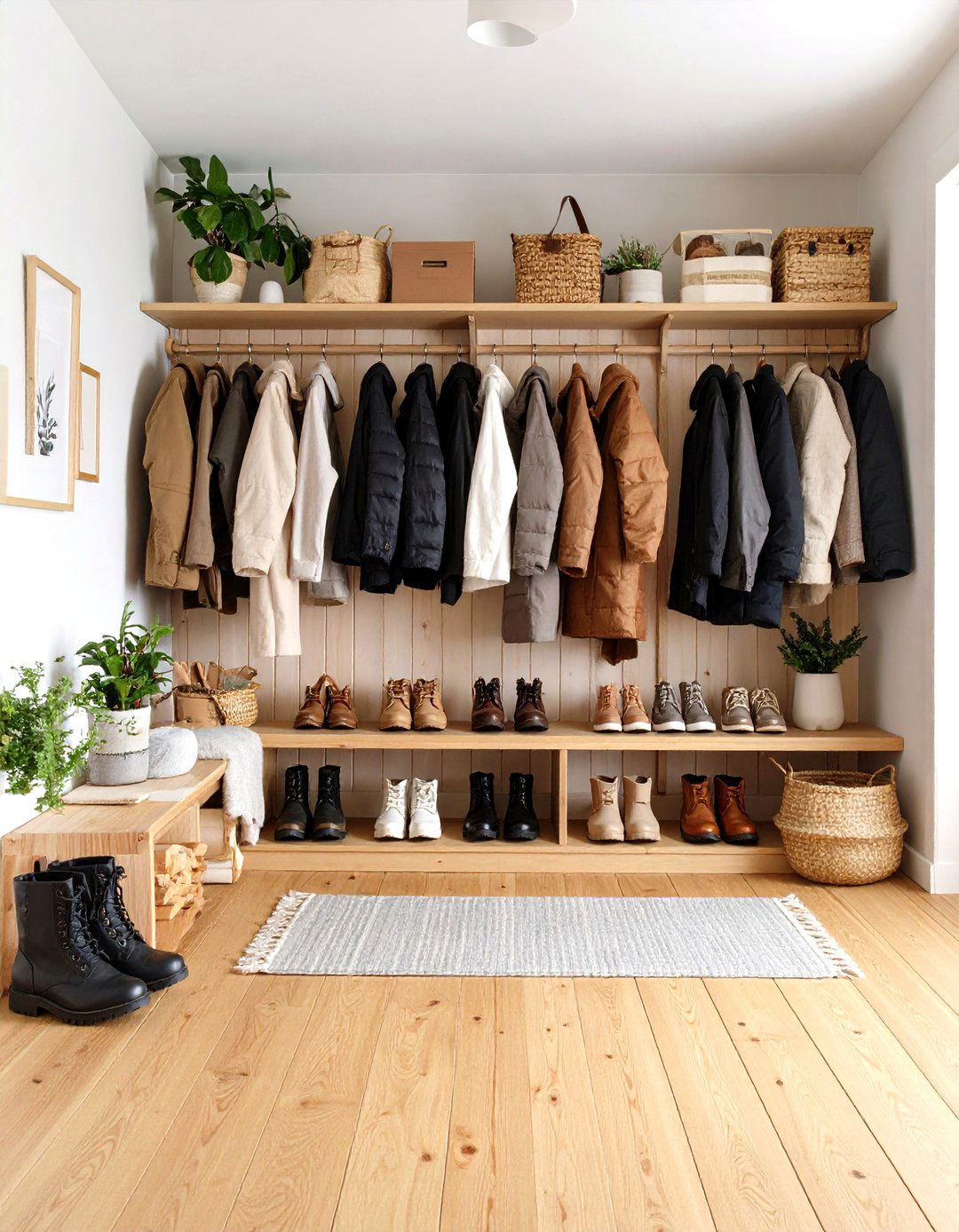
A Scandinavian-inspired boot room embraces light wood paneling and minimalist design principles to create a calming, organized entrance space. Using a light wall paneling idea and matching wooden floor, this boot room design is 'snygg' — that's stylish in Swedish to you and I. This design approach features pale wood tones, clean lines, and functional storage that doubles as decorative elements. To add the hygge factor to your home, add a rattan umbrella stand and felt bags to store wood briquettes for aesthetics, or actual burning abilities. A wall mounted shelf-cum-coat-hooks will also allow you to hand rain macs, scarfs and handbags. The Scandinavian boot room typically includes natural fiber accessories like woven baskets, simple wooden benches with clean geometry, and neutral color palettes that create a sense of tranquility and order while maintaining the practical functionality essential for muddy boot storage.
4. Boot Room Industrial Style with Metal Lockers
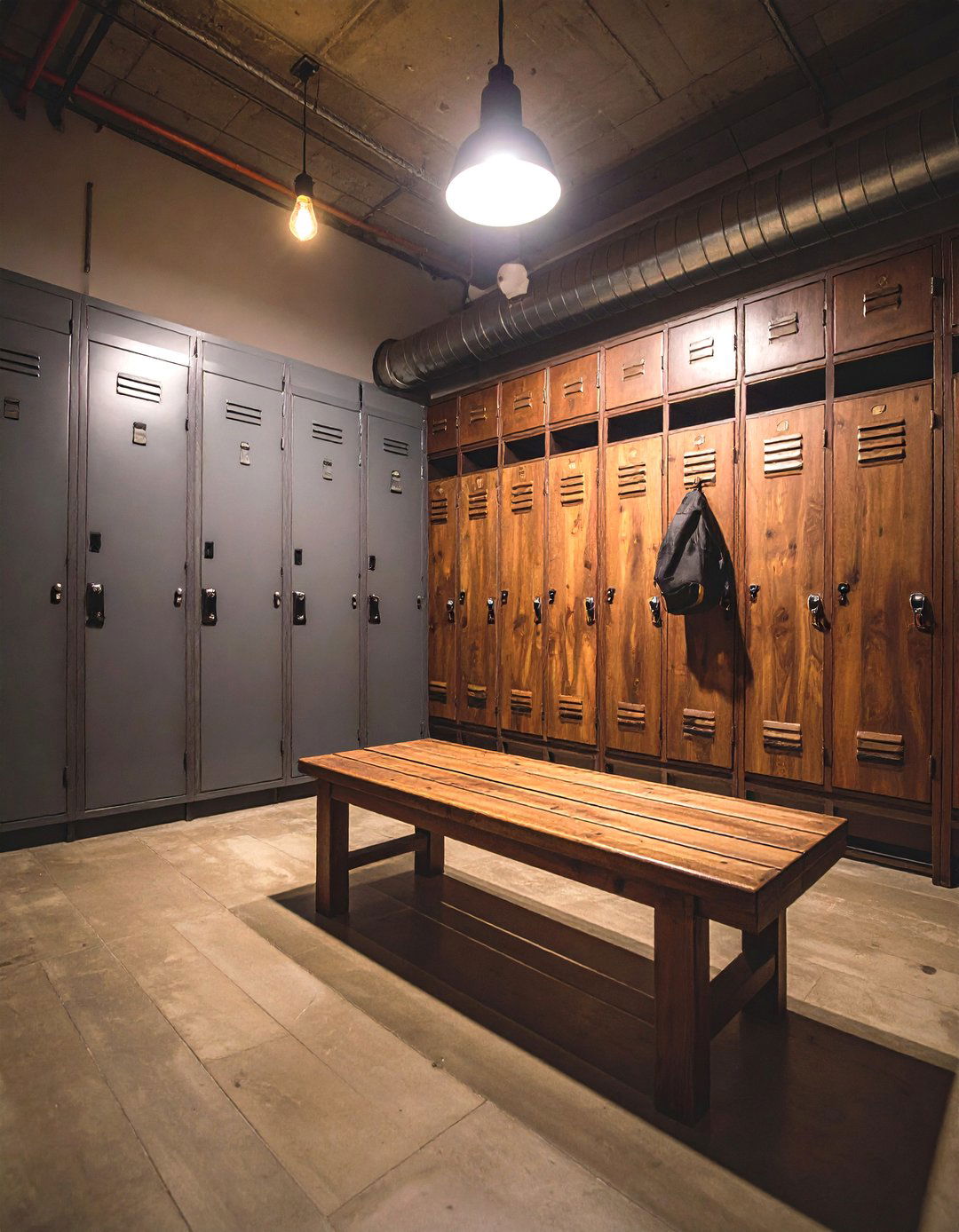
An industrial-style boot room incorporates metal lockers and utilitarian design elements to create a robust, organized storage solution reminiscent of vintage changing rooms. This approach features powder-coated steel lockers in colors like charcoal gray or forest green, providing individual storage compartments for each family member's gear. The rich charcoal paint in this concept creates a classic backdrop for a selection of basic freestanding units, as well as matching coat hooks and shelving. Industrial boot rooms often include concrete or polished concrete floors, exposed piping painted in coordinating colors, and vintage-style lighting fixtures with metal shades. This industrial design in mango wood with an iron frame includes a bench, shelf and hanging space. The metal elements provide exceptional durability for high-traffic use while the industrial aesthetic adds character and prevents the space from feeling too precious or delicate for its intended muddy-boot purpose.
5. Boot Room with Butler Sink and Dog Washing Station
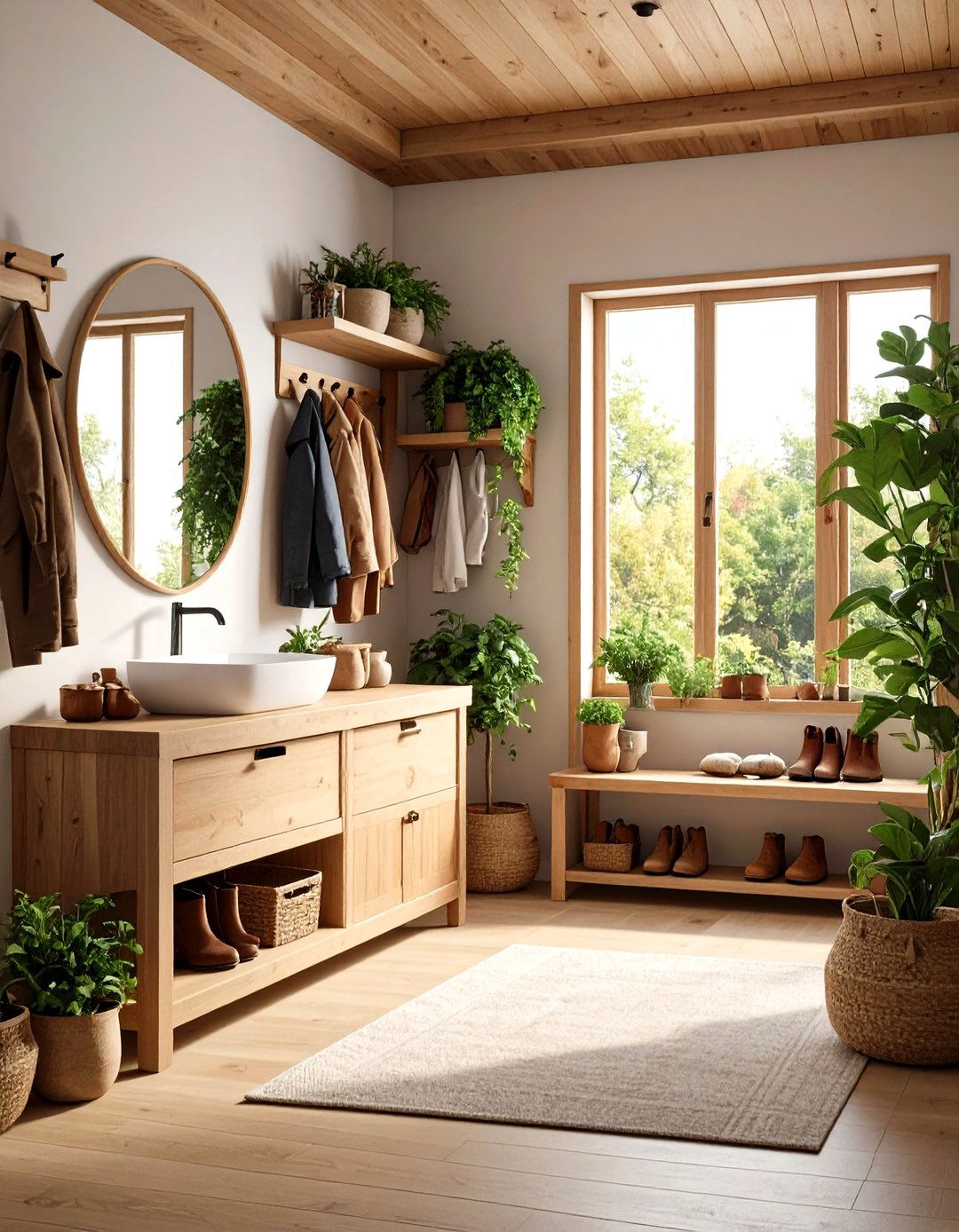
A boot room equipped with a deep butler sink and dedicated dog washing area transforms the space into a comprehensive cleaning station for both gear and pets. The classic farmhouse sink has the depth needed in a boot room, whether you're cleaning football boots, trimming cut flowers, or even washing down your pet. This design typically features a large ceramic sink with high sides, pull-out spray taps for versatility, and surrounding storage for cleaning supplies and dog grooming equipment. The pampered pooch in this concept image has its own step-in dog shower and cosy dog crate to chill out on one side of the room, keeping the laundry appliances and work surfaces on the opposite side of the room well clear of the splash zone. Additional features often include non-slip flooring, drainage solutions, heated towel rails for drying pets, and dedicated storage for leashes, toys, and grooming supplies. This multipurpose approach maximizes the room's functionality for active families with outdoor-loving pets.
6. Boot Room Small Bench with Hidden Storage
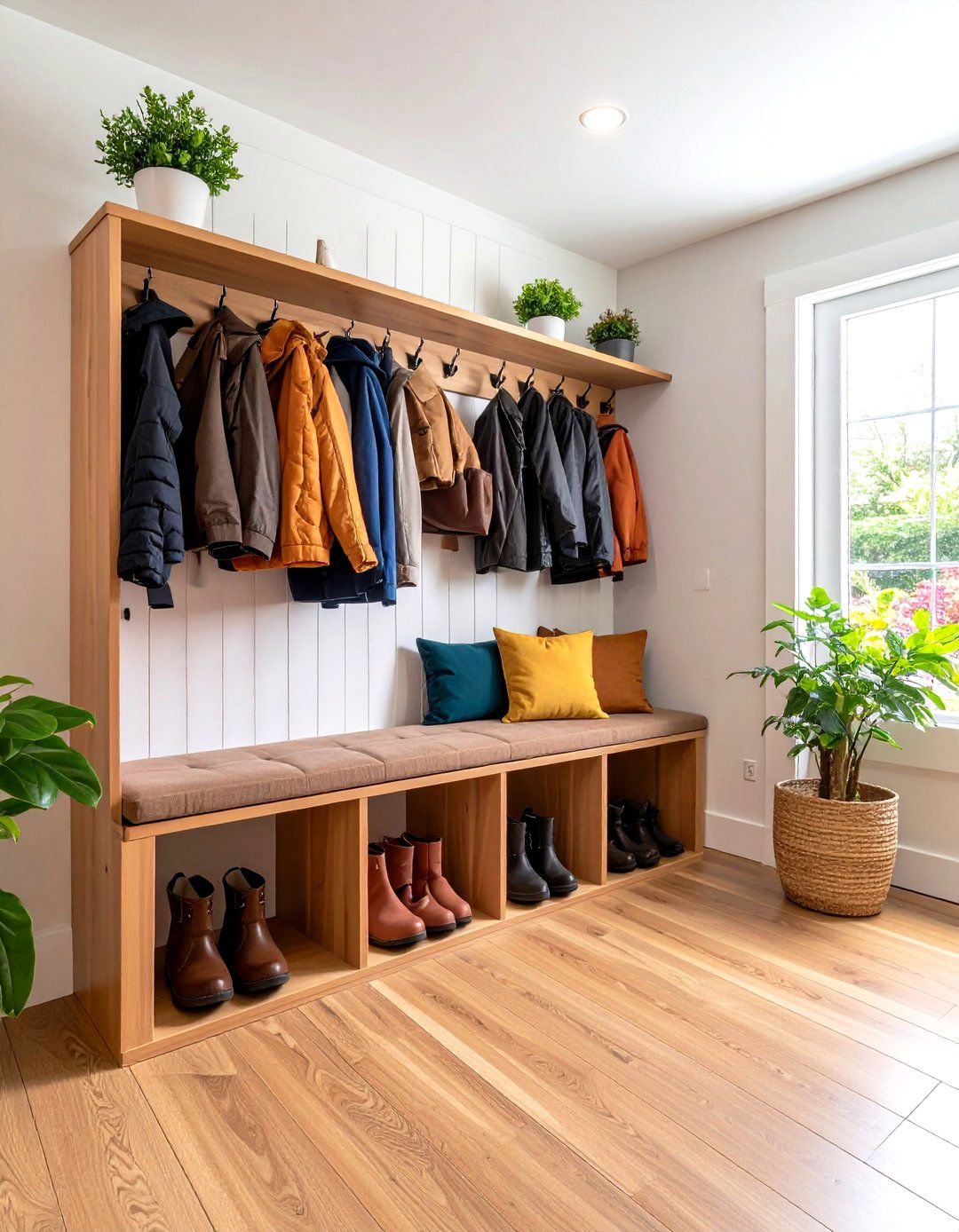
A compact boot room bench with hidden storage compartments provides essential seating and organization without overwhelming smaller spaces. Maximize small boot room ideas with a bench seat featuring a hinged lid. Here, the space beneath the bench is divided between enclosed and open storage – a good idea if you want to keep muddy boots separate from other items. These benches typically feature lift-up tops with slow-close hinges, divided internal compartments for organizing different types of footwear, and cushioned seating in washable, moisture-resistant fabrics. Not only will you enjoy a handy spot to remove your own shoes, and help children with their laces, but the space underneath can also be used for extra storage. The design often incorporates additional features like built-in shoe slots along the base, side pockets for smaller accessories, and coordinating wall-mounted hooks positioned directly above the bench. This solution works particularly well in narrow hallways or small entryways where every square inch matters.
7. Boot Room Outdoor Shed Conversion
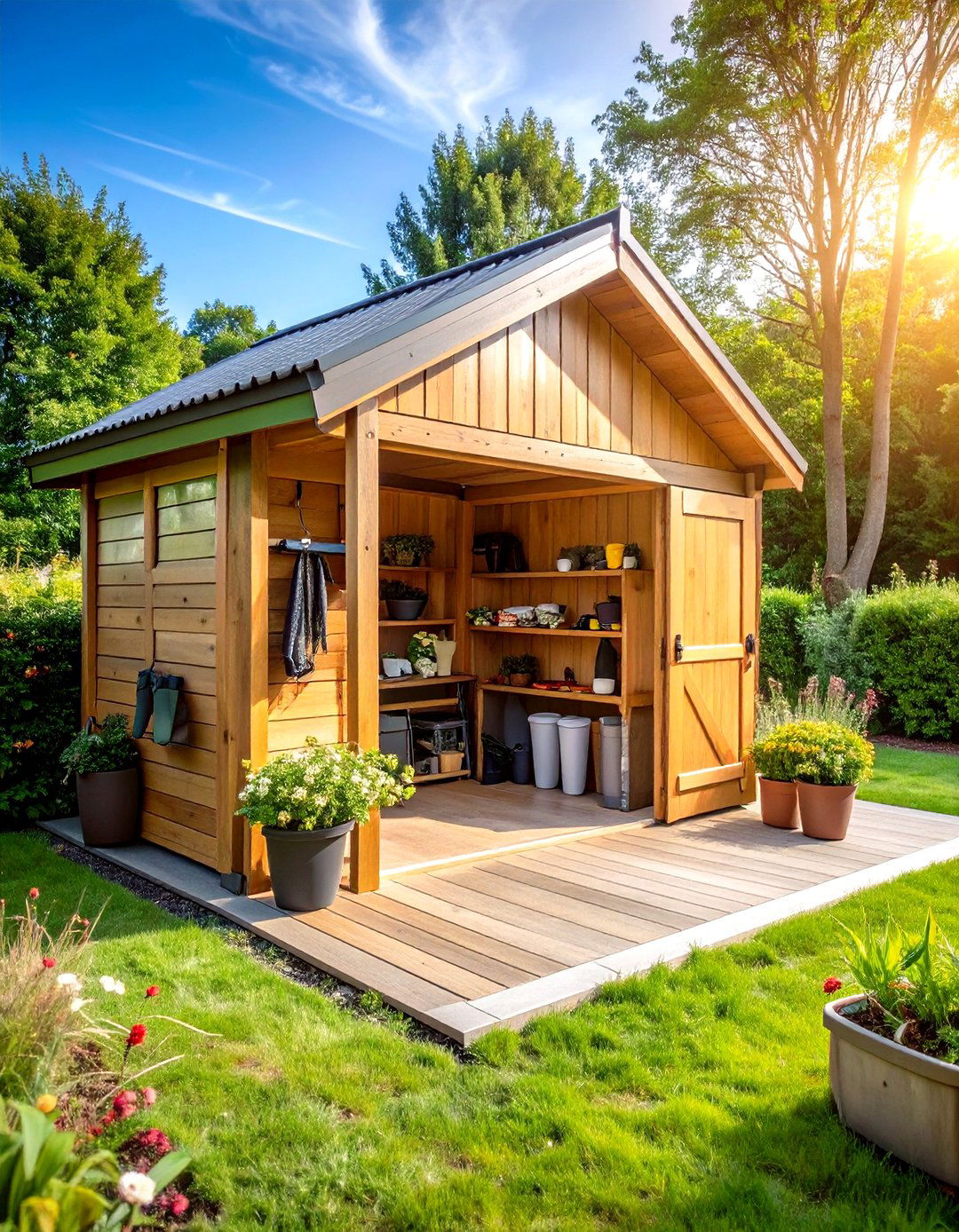
Converting an outdoor shed or building a dedicated outdoor boot room creates the ultimate buffer zone between garden activities and indoor living spaces. In an outdoor boot room, a place to safely store all your gardening equipment and tools is key. This design approach features weather-resistant storage solutions, proper ventilation systems, and durable materials that can withstand temperature fluctuations and humidity. We love the novel hanging space in this concept, created by upcycling a ladder. Not only has it been painted to match the vibrant wall colour, but it provides a handy narrow shelf too. Outdoor boot rooms typically include wellington boot storage with proper drainage, tool organization systems, potting bench areas for gardening tasks, and secure storage for valuable equipment. You could easily attach some garden twine to create a lightweight drying line to peg up wet gardening gloves. This solution particularly appeals to keen gardeners and those with messy outdoor hobbies who want to keep all related gear completely separate from indoor spaces.
8. Boot Room with Terracotta Tile Flooring
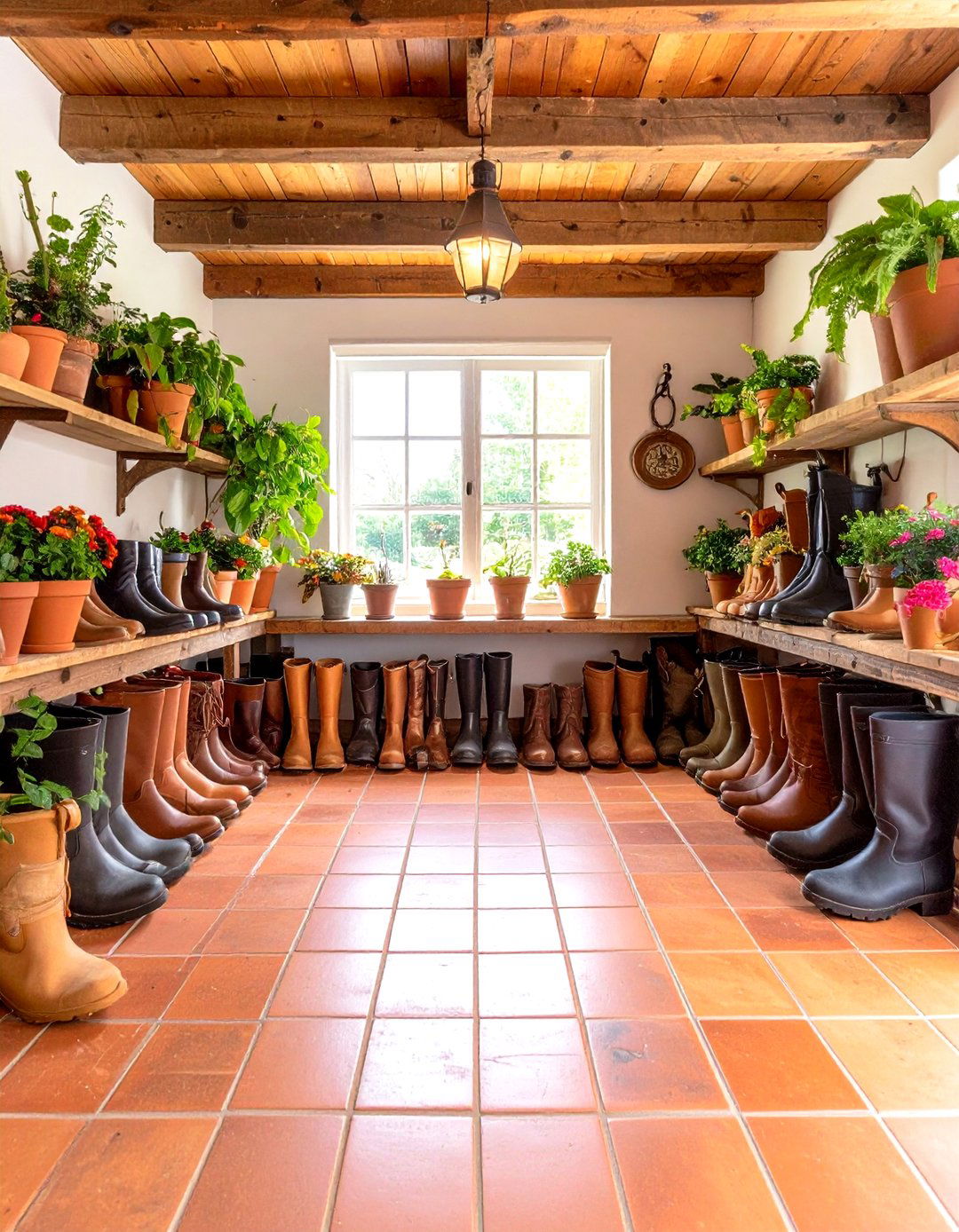
Terracotta tile flooring provides a warm, rustic foundation for boot rooms while offering exceptional durability and easy maintenance for high-traffic areas. If you're a fan of the rustic aesthetic, do consider terracotta tiles for your boot room. Versatile, durable and naturally low-maintenance, they work well in high-use areas. This flooring choice creates an authentic, country-house atmosphere while being practical enough to handle daily mud and moisture. Their warm, earthy tones look amazing, and add instant charm and character to any interior (and indeed exterior) space. The great part about our reclaimed brick floor is that it only looks better with age. Once sealed correctly you have a floor that is easy to clean and can stand up to a lot of foot traffic. Terracotta tiles can be laid in various patterns including herringbone, stretcher bond, or traditional square layouts, each creating different visual effects. The natural variation in color and texture helps disguise dirt and wear while complementing both traditional and contemporary boot room designs with their timeless appeal.
9. Boot Room Combined Laundry Room
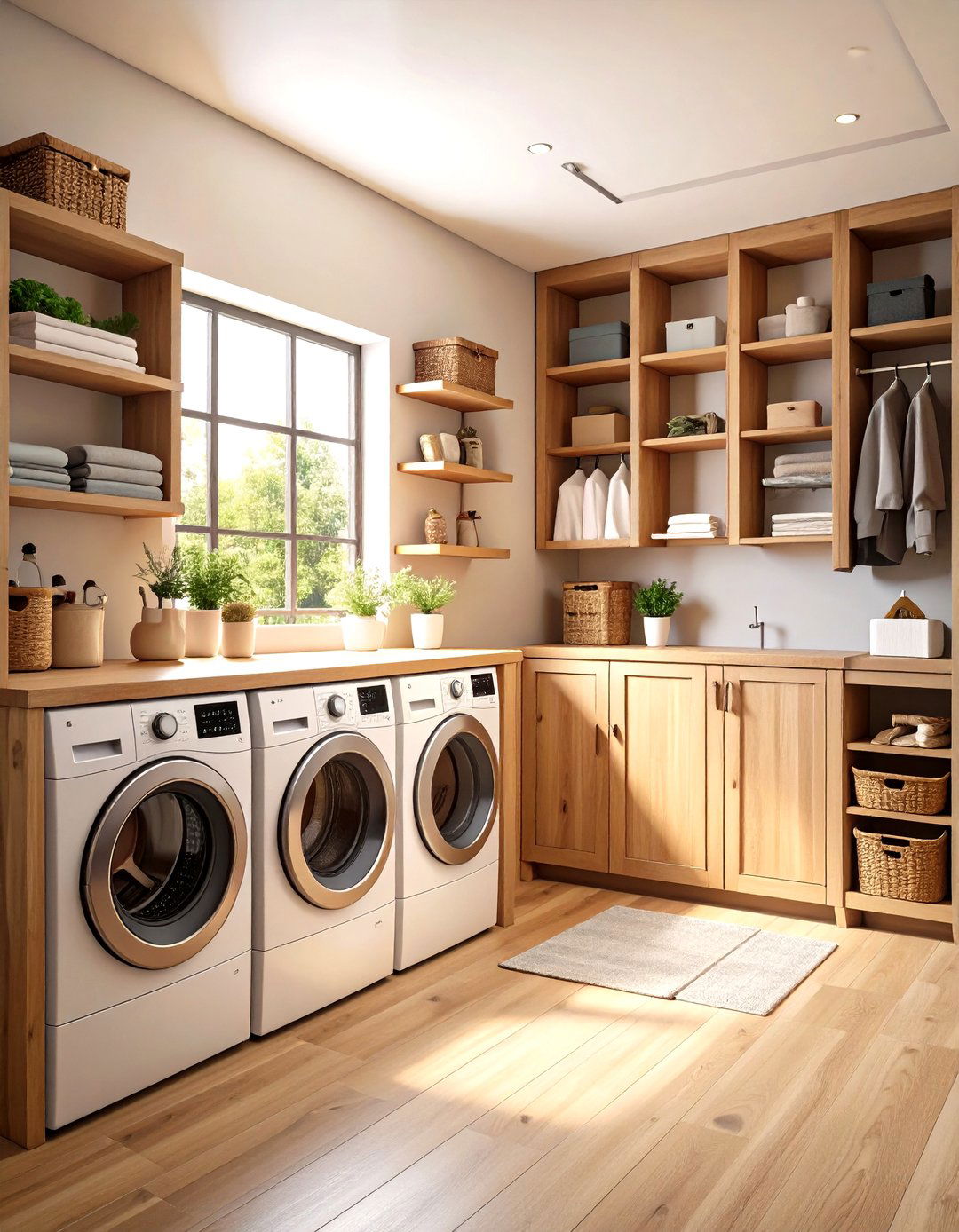
A boot room that doubles as a laundry facility maximizes space efficiency by combining two practical functions in one well-organized area. However, if you have the space, it is possible to design a harmonious solution. This design typically features dedicated zones that separate clean laundry activities from muddy outdoor gear storage, often using physical barriers or distinct areas within the same room. Consider storing utilities that don't fit in the kitchen. It is very common and quite sensible to have the washer/dryer sitting bedside the sink, even in a smaller boot room. The layout usually includes stacked or side-by-side washing machines and dryers, folding countertops with storage above and below, and separate areas for hanging wet outdoor clothing away from clean laundry. To save space, incorporate a tall cabinet so that your appliances can be stacked. Proper ventilation becomes crucial in these dual-purpose spaces to manage moisture from both wet outdoor gear and laundry activities, often requiring enhanced extraction systems and heating solutions.
10. Boot Room with Individual Family Lockers
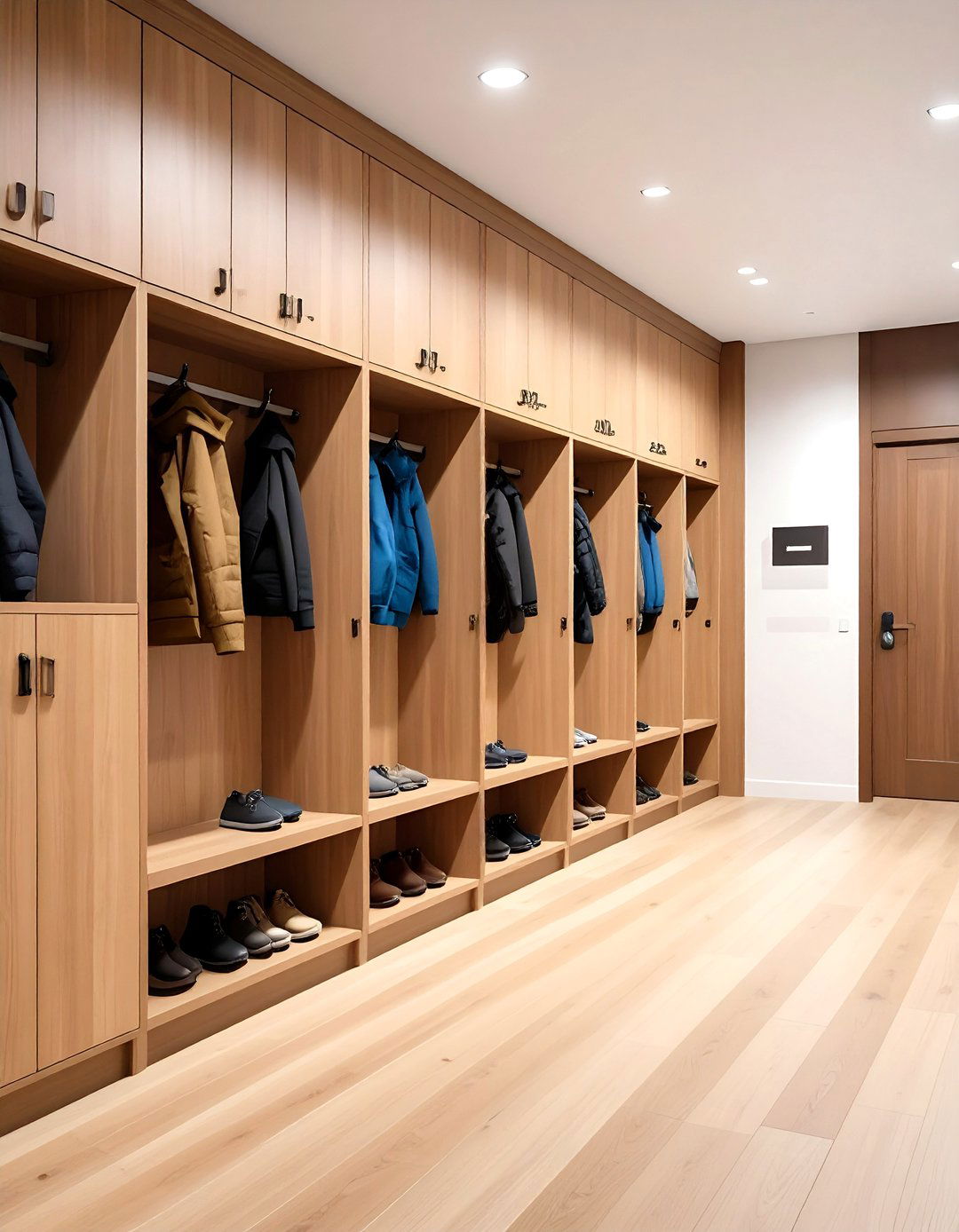
Individual family lockers create a personalized organizational system that assigns each household member their own dedicated storage space within the boot room. As well as individual storage areas for each family member, complete with overhead lockers, hooks, a bench and space to stash footwear, every other inch of space is utilized. This approach typically features tall, narrow compartments labeled or color-coded for each person, including children and pets, with varying heights and configurations to accommodate different needs. This tall elegant cabinet has been divided to give each family member a dedicated space for outdoor gear and shoes for the ultimate organized scheme. Each locker section usually includes coat hooks at appropriate heights, shoe storage cubbies, shelving for accessories like gloves and hats, and sometimes electrical outlets for charging devices. Allocate each member of your household (including pets!) their own peg and storage space to keep the area neat and organized. This system encourages personal responsibility for organization while preventing the chaos that can develop when everyone's items are mixed together in communal storage areas.
11. Boot Room with Heated Towel Rail and Drying Space

Incorporating heated towel rails and dedicated drying areas transforms a boot room into an efficient space for thoroughly drying wet outdoor gear and clothing. Heating your boot room might not be at the top of your to-do list, but it's not one to be neglected. This design features wall-mounted heated towel rails, retractable drying lines, and adequate ventilation to prevent moisture buildup and mildew formation. By their nature, they often contain wet items of clothing so you need to be able to regulate the temperature to avoid the entire room feeling cold and damp. The solution is to utilize vertical space and suspend a laundry drying rack for damp clothing. It will allow air to circulate (warm air rises), and the rack can be pulled up and out of the way until needed. Additional features often include underfloor heating for comfort and drying efficiency, dehumidifiers for moisture control, and strategic placement of heating elements near shoe storage areas. After a cold walk in the rain, the warmth under feet is an indulgence, but it also aids drying wet boots, shoes, or dogs. This approach ensures gear dries completely, preventing odors and extending the life of expensive outdoor equipment.
12. Boot Room Porch Extension
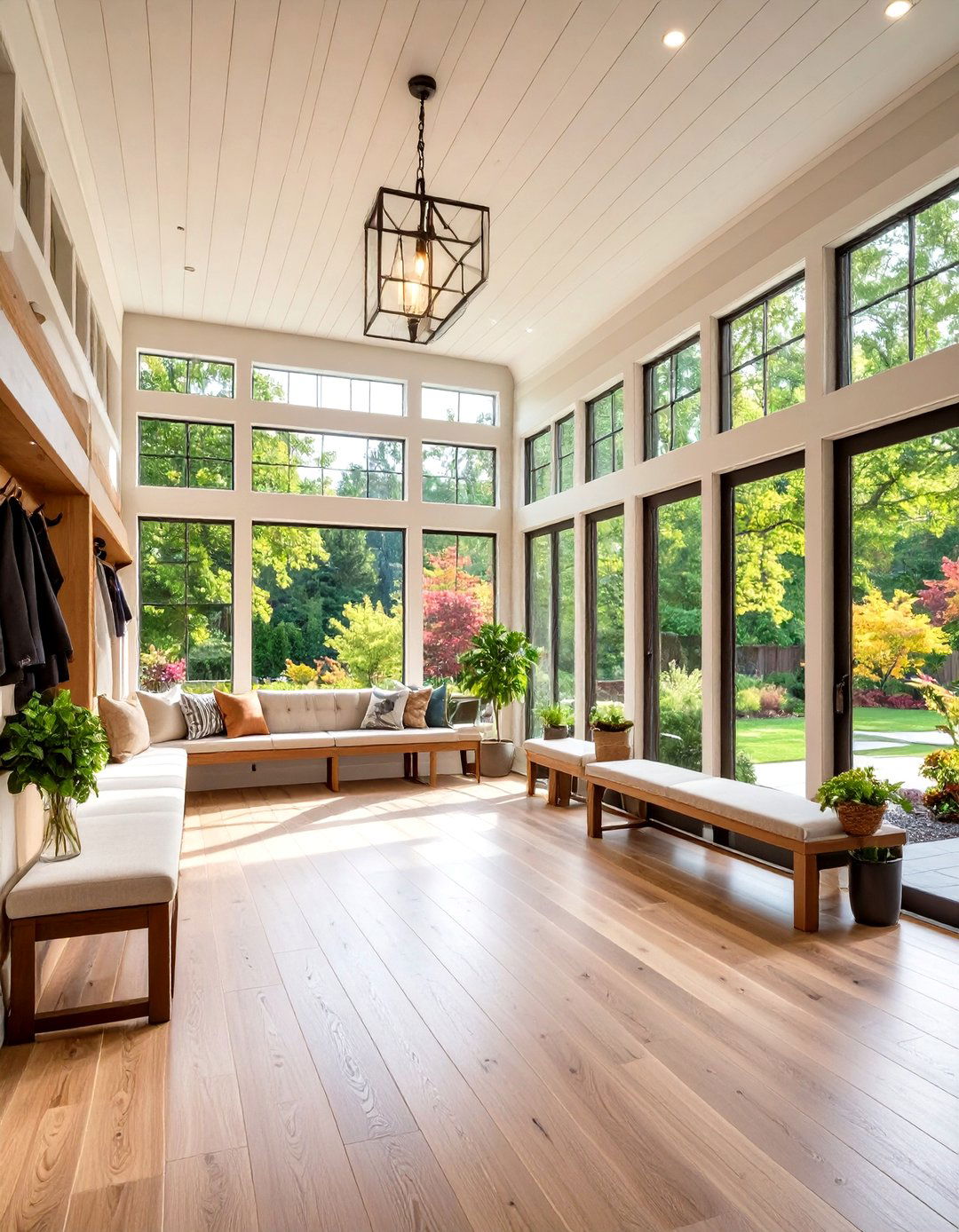
A boot room porch extension creates a seamless transition between outdoor and indoor spaces while providing weather protection and ample storage for the whole family. If you don't have a separate boot room, consider incorporating storage into your front porch ideas so it can double-up as one. This design typically features glazed walls or large windows that provide natural light while maintaining protection from the elements, along with durable flooring that can handle tracked-in moisture and debris. Charlotte Crosland designed this entrance with a glass pitched roof to add light and a feeling of space, helping to balance all the cubbies and hooks for coats. The porch extension usually includes built-in storage benches, coat hanging areas, and shoe organization systems that work efficiently within the architectural framework. A small porch or entrance valve to your boot room will ensure cold windy weather is kept at bay. This solution works particularly well for homes without existing utility space, creating a proper airlock that prevents outdoor elements from entering the main house while providing the storage and organization benefits of a traditional boot room.
13. Boot Room with Built-In Seating and Cubbies
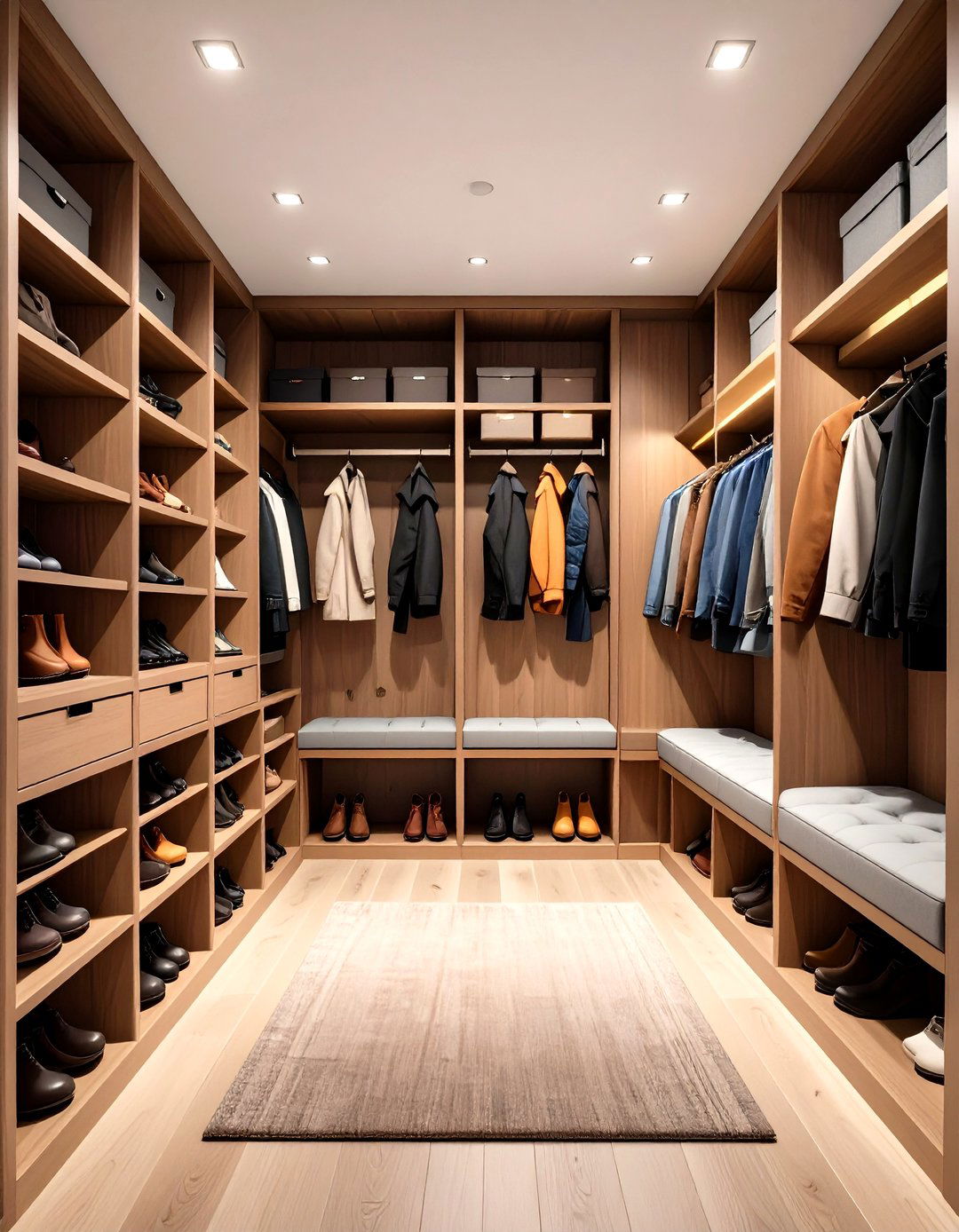
Built-in seating combined with integrated cubby storage creates a cohesive, space-efficient boot room solution that maximizes both functionality and comfort. Surround the seating with concealed cupboards to make the seating the focal point. This design approach features custom-built bench seating with individual storage compartments underneath and surrounding cubby holes designed to accommodate different types and sizes of footwear. Cubbies are ideal for organising all the random bits and bobs that can often end up in a Boot room. Not only are they ideal for boots and shoes, they can house baskets and canisters too, keeping a curb on the clutter. The seating typically includes comfortable cushioning in washable, moisture-resistant fabrics, while the cubbies feature adjustable shelving and sometimes removable tray inserts for easy cleaning. Factor in essentials, including hanging space for coats, cubbies and baskets, shoe and boot storage, and any bespoke fittings you may need – storage for tennis racquets or paddle boards, for example. This integrated approach creates a streamlined appearance while providing dedicated spaces for every family member's gear, encouraging organization and making daily routines more efficient.
14. Boot Room with Stone Flagstone Flooring
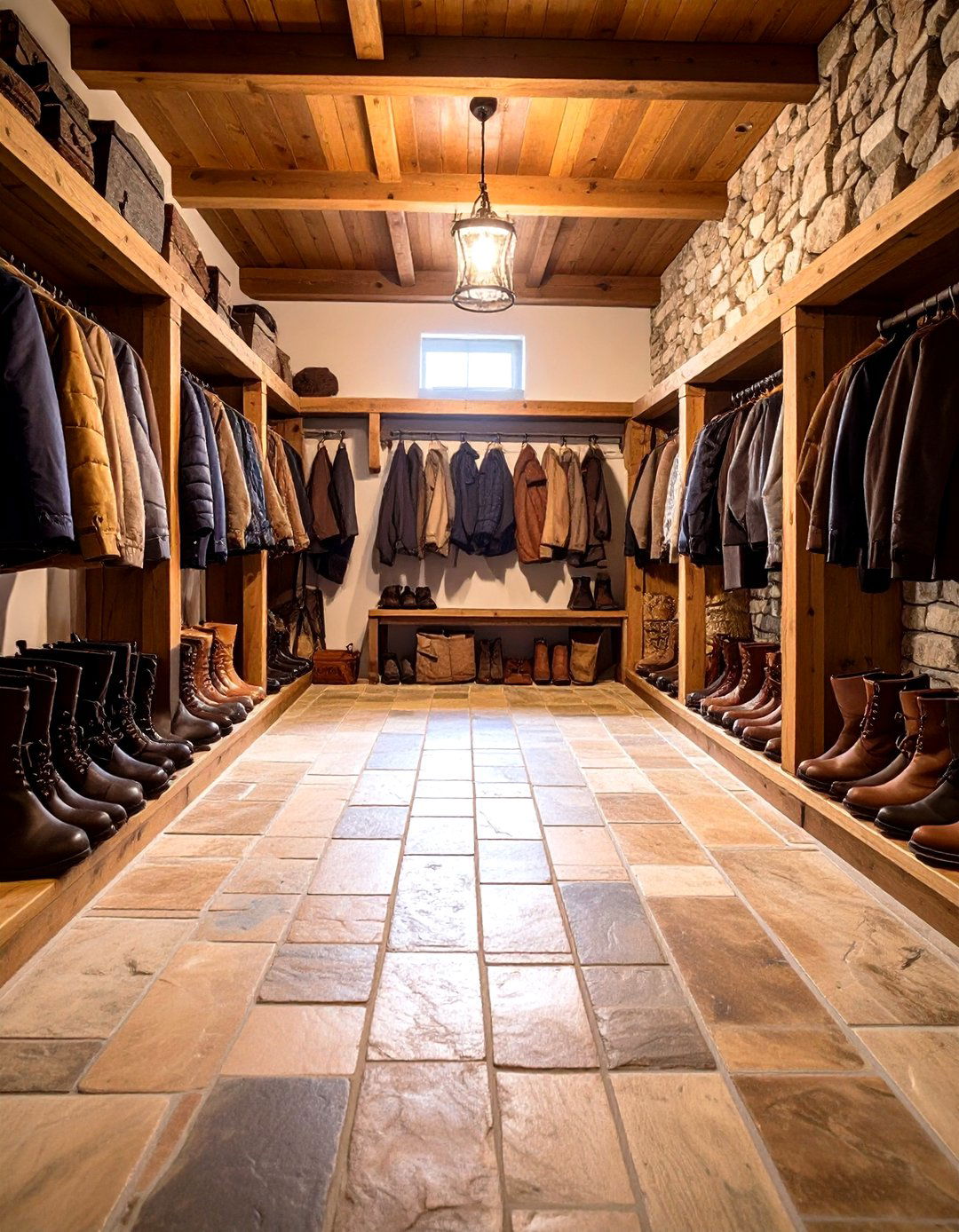
Natural stone flagstone flooring provides an authentic, durable foundation for boot rooms that improves with age and handles the heaviest traffic with elegance. If you're looking for natural stone tiles to create an authentic boot room appearance, limestone, sandstone and terracotta floor tiles are a brilliant choice. Hardwearing, durable and low maintenance, sealed natural stone tiles make the perfect boot room flooring that will last for years to come. This traditional flooring choice creates a sophisticated country house atmosphere while being practically suited for muddy boots and wet conditions. Natural stone is always an excellent choice, as it's durable, hardwearing, low maintenance and compatible with underfloor heating. Many products also look better with age as they become more weathered and worn-in. Stone flagstones can be sourced in various colors from honey-colored limestone to deep gray slate, each bringing different character to the space. Natural stone flooring is a durable and practical choice for a boot room, loved for its hardwearing nature and forgiving surface. The natural variation in stone color and texture helps conceal dirt and wear while providing excellent slip resistance when properly finished and sealed.
15. Boot Room with Shaker Style Cabinetry
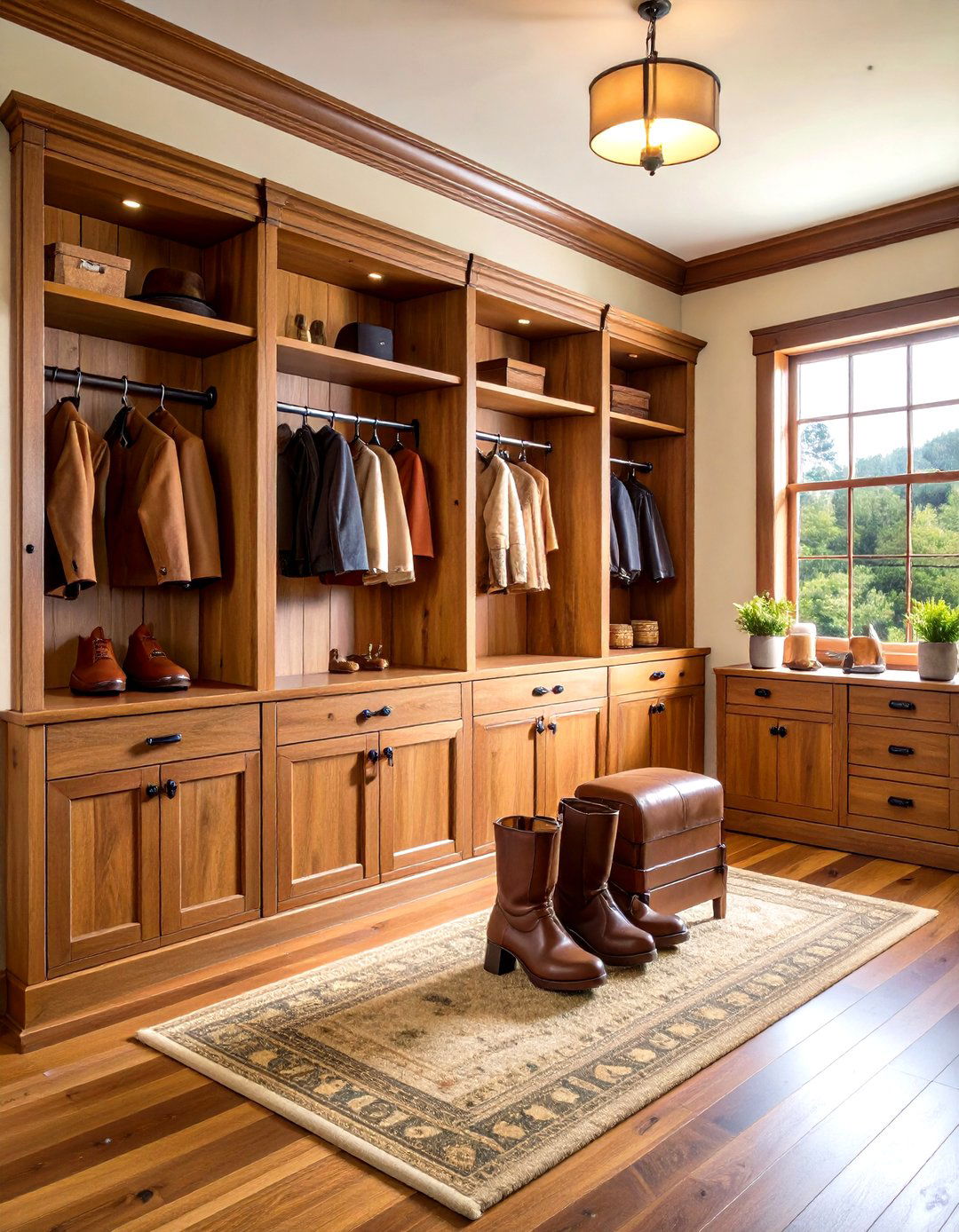
Shaker-style cabinetry brings timeless elegance to boot room design through clean lines, quality construction, and versatile styling that complements both traditional and contemporary homes. This design approach features frame-and-panel cabinet doors with minimal hardware, creating an uncluttered appearance that emphasizes functionality over ornamentation. So while boot room ideas can often comprise of more traditional design elements, including shaker style cupboards, wall panelling and darker colours - all of which have a place and will be covered in this article. Shaker-style boot rooms typically incorporate painted finishes in sophisticated colors like sage green, navy blue, or classic white, often coordinated with the home's existing color palette. The cabinet construction emphasizes durability with solid wood frames and quality hardware designed to withstand heavy daily use. Boot rooms are most often positioned next to a kitchen so it makes sense to replicate the same colours and designs. This style works particularly well when the boot room connects to a kitchen, creating visual continuity throughout the home's service areas while maintaining the practical organization essential for outdoor gear storage.
16. Boot Room with Pull-Out Drying Rack Systems
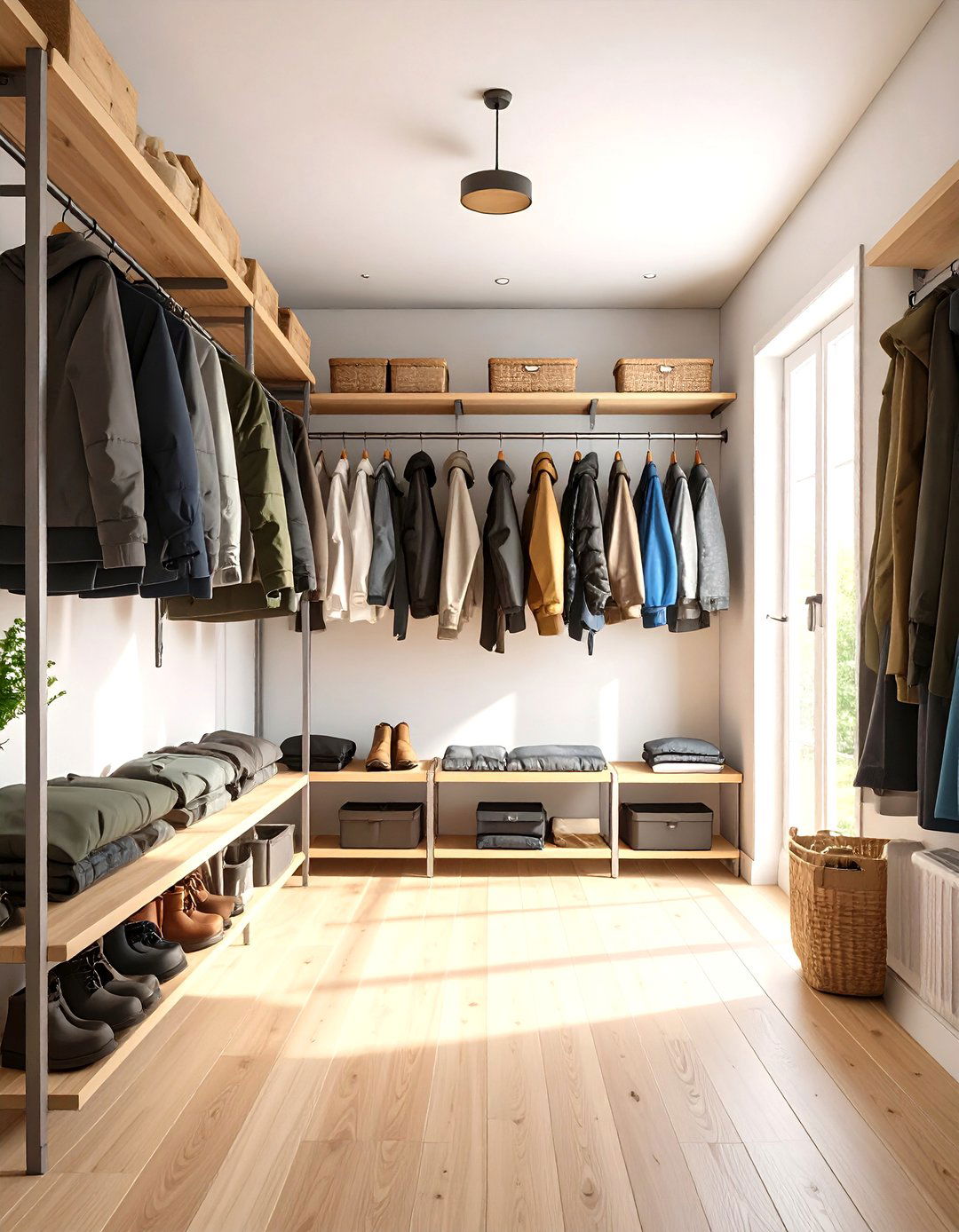
Pull-out drying rack systems provide space-efficient solutions for thoroughly drying wet outdoor clothing and gear without permanently occupying valuable boot room floor space. These innovative storage solutions typically feature wall-mounted or cabinet-integrated drying racks that extend when needed and retract when not in use, maximizing the room's dual functionality. The solution is to utilize vertical space and suspend a laundry drying rack for damp clothing. It will allow air to circulate (warm air rises), and the rack can be pulled up and out of the way until needed. The systems often include multiple extending arms or accordion-style frameworks that can accommodate various garment types from heavy coats to delicate gloves. Strategic placement near heating sources or ventilation systems enhances drying efficiency while preventing moisture-related problems like mildew or unpleasant odors. Again, underfloor heating, natural ventilation and/or a dehumidifier will help keep the space dry. These practical additions prove especially valuable for active families who regularly return with wet weather gear, sports equipment, or outdoor work clothing that requires proper drying before storage.
17. Boot Room with Vintage Coat Hooks and Rustic Styling

A vintage-inspired boot room featuring antique coat hooks and rustic styling elements creates characterful storage that celebrates traditional country house aesthetics. Just because wall hooks are a practical feature doesn't mean they need to be boring. This design approach incorporates reclaimed materials, weathered finishes, and period-appropriate hardware to achieve an authentic aged appearance. We love the novel hanging space in this concept, created by upcycling a ladder. Not only has it been painted to match the vibrant wall colour, but it provides a handy narrow shelf too. Typical elements include cast iron or brass coat hooks in varying designs, reclaimed wood shelving with natural wear patterns, and vintage-style baskets for organizing smaller accessories. To get the country look, revamp old furniture with a fresh coat of paint and add wicker baskets or crates for storage. The rustic styling often extends to flooring choices like reclaimed brick or wide-plank wooden boards, complemented by traditional paint colors and natural fiber accessories. This approach appeals to those seeking to create an authentic period atmosphere while maintaining practical modern functionality for daily family use.
18. Boot Room with Porcelain Wall Tiles and Backsplash

Porcelain wall tiles and backsplash installations provide easy-clean surfaces that combine practical maintenance with design versatility in boot room applications. If your boot room – or utility room – has a sink, a tiled backsplash is one of my preferred boot room ideas. Like the floor, this will need to be durable and water-resistant. These installations typically feature moisture-resistant porcelain tiles that can withstand frequent cleaning and resist staining from muddy splashes or wet gear. Your backsplash should also be easy to clean and maintain, making porcelain a firm favourite in terms of materials. The design possibilities include subway tiles for classic appeal, large format tiles for contemporary looks, or patterned tiles that add visual interest while disguising minor dirt and wear. Backsplash tiles can make a big visual impact in a boot room, especially if the area they cover is large. As they are usually sited at eye level, they're often the first thing any visitors will notice. Strategic placement around sinks, work surfaces, and high-splash areas protects underlying wall surfaces while creating opportunities for introducing color, pattern, or texture that elevates the boot room from purely utilitarian to stylishly functional space.
19. Boot Room Garage Conversion
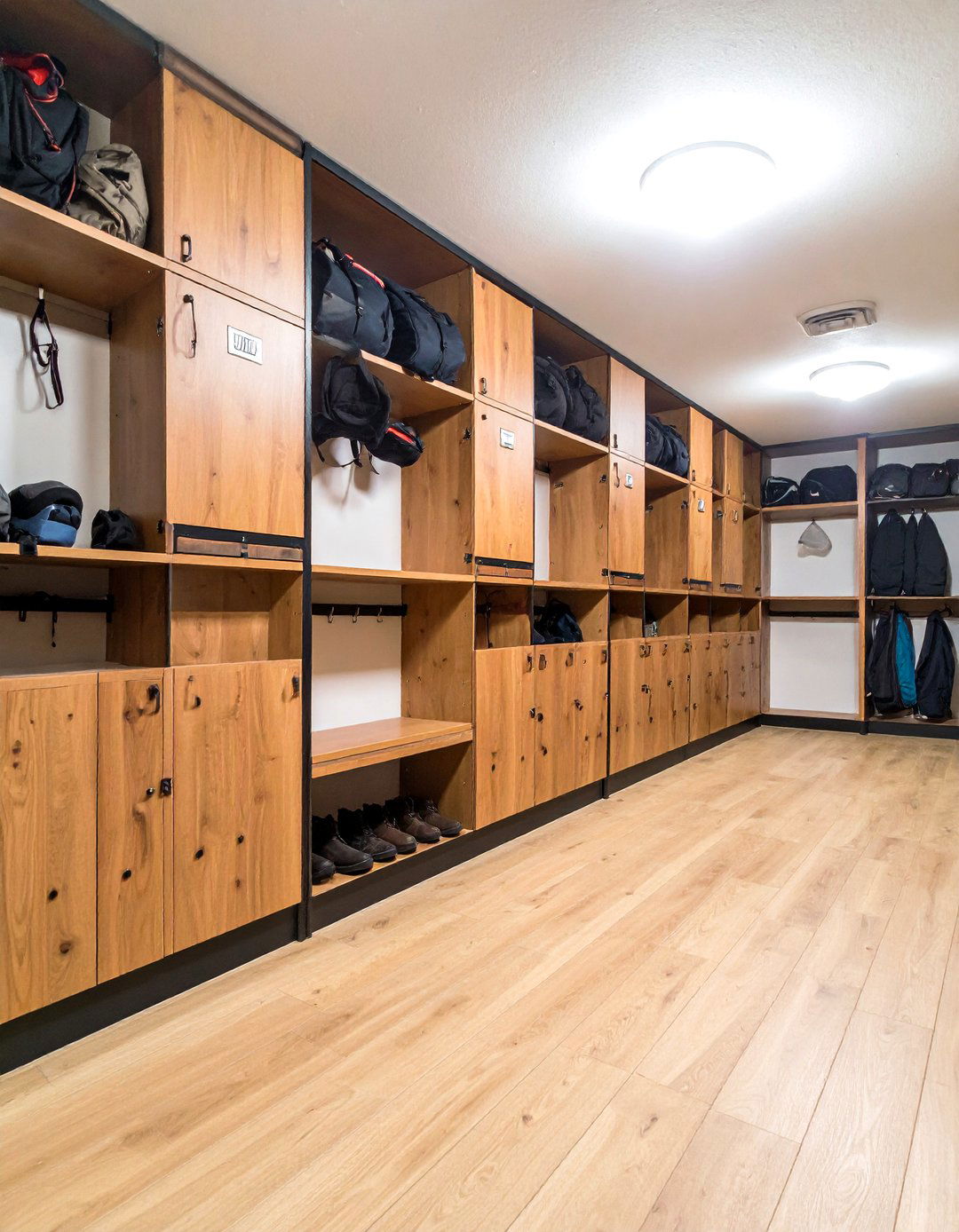
Converting garage space into a dedicated boot room creates expansive storage and organization possibilities for households with significant outdoor gear requirements. In a busy household, many homeowners are choosing to convert the garage or into a useful boot room space. With an entire room dedicated to boot room storage, you can dream up all manner of designs to suit your needs. This conversion typically requires insulation improvements, moisture management systems, and proper heating to create comfortable year-round use from previously unheated space. The generous square footage allows for comprehensive storage solutions including individual family lockers, gear-specific storage areas for sports equipment, and dedicated spaces for seasonal items like holiday decorations or outdoor furniture cushions. If you don't have a garage, why not explore basement mudroom ideas along a similar theme. Garage conversions often include direct access to outdoor areas, large format flooring suitable for heavy equipment, and electrical systems that can support multiple appliances. This solution particularly appeals to active families with extensive outdoor gear, multiple vehicles' worth of equipment, or those who want to create the ultimate organizational space without compromising interior living areas.
20. Boot Room with Multi-Level Storage Systems
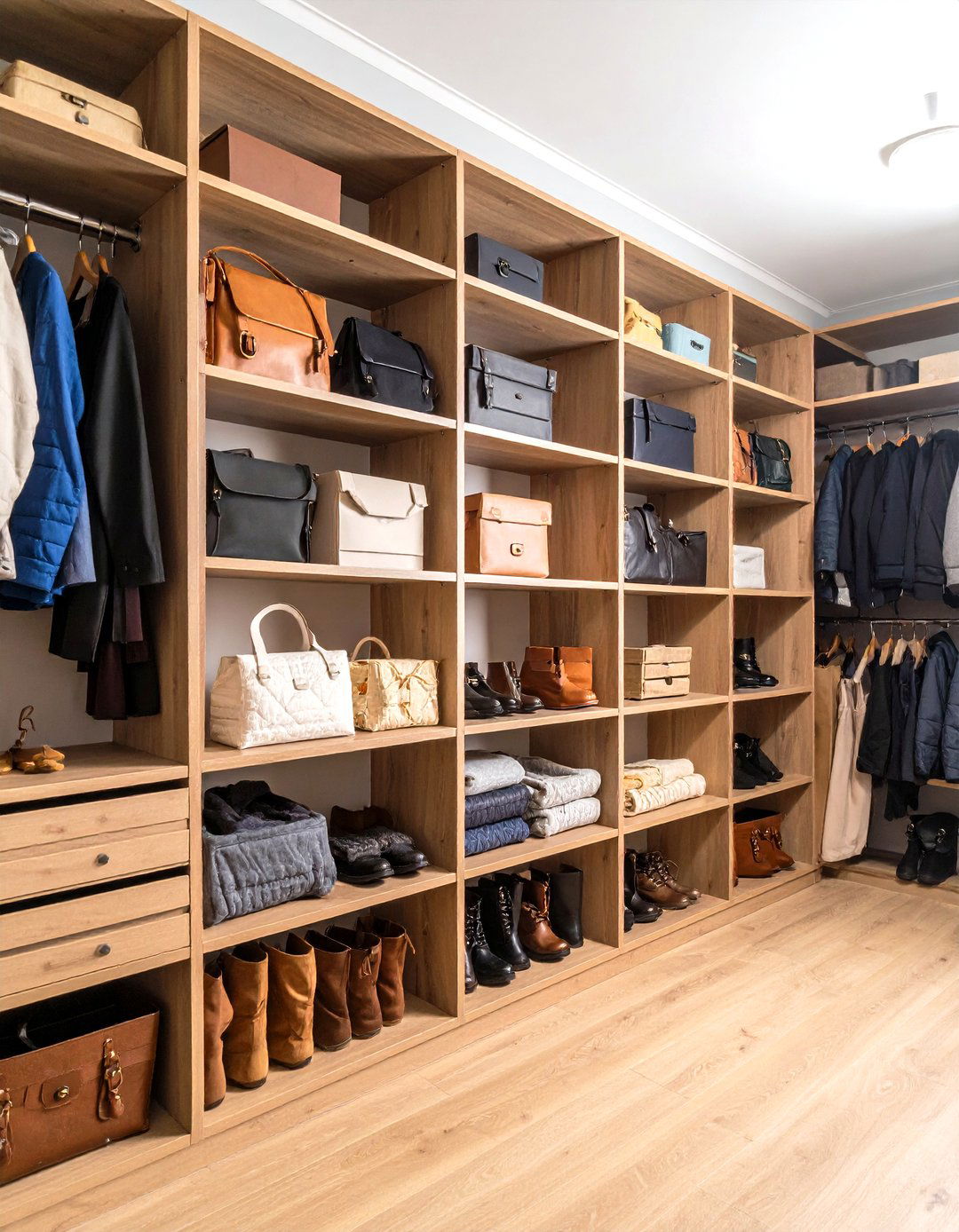
Multi-level storage systems maximize vertical space efficiency through carefully planned combinations of floor, mid-level, and overhead storage solutions tailored to different user heights and item types. When planning the position of coat racks, set them at a suitable height to encourage children to hang up coats and put away shoes. Here all options are covered, with a handmade shoe store at two heights, a double row of coat racks and overhead storage. This approach typically features low-level cubbies and drawers for shoes and heavy items, mid-level hanging areas and open shelving for daily-use items, and high-level enclosed storage for seasonal or rarely-used gear. You'll need three levels of storage; cubby holes and drawers near floor level for shoes, hanging racks for coats and jackets, and a high shelf for less used items, such as cycling helmets. The system often incorporates adjustable components that can adapt as family needs change, ladder access for high storage areas, and clear sight lines to prevent forgotten items in upper zones. Think about positioning hooks at head height for adults, plus a lower rail that children can reach easily. This comprehensive approach ensures every family member can easily access their belongings while maximizing storage capacity within the available footprint.
Conclusion:
These 20 boot room ideas demonstrate that functional storage spaces can be both practical and stylish, regardless of available space or budget. From compact under-stair conversions to expansive garage transformations, each approach addresses the fundamental need for organized transition zones between outdoor and indoor living. Done well, a boot room will not only transform how you enjoy your entire home and improve your level of organisation, but it'll also add value to your property. Success lies in choosing solutions that match your family's lifestyle, incorporating durable materials that handle daily wear, and creating systems that encourage regular use. Whether you prefer traditional country house styling or contemporary minimalist design, the right boot room will streamline daily routines while protecting your home's interior from outdoor elements.


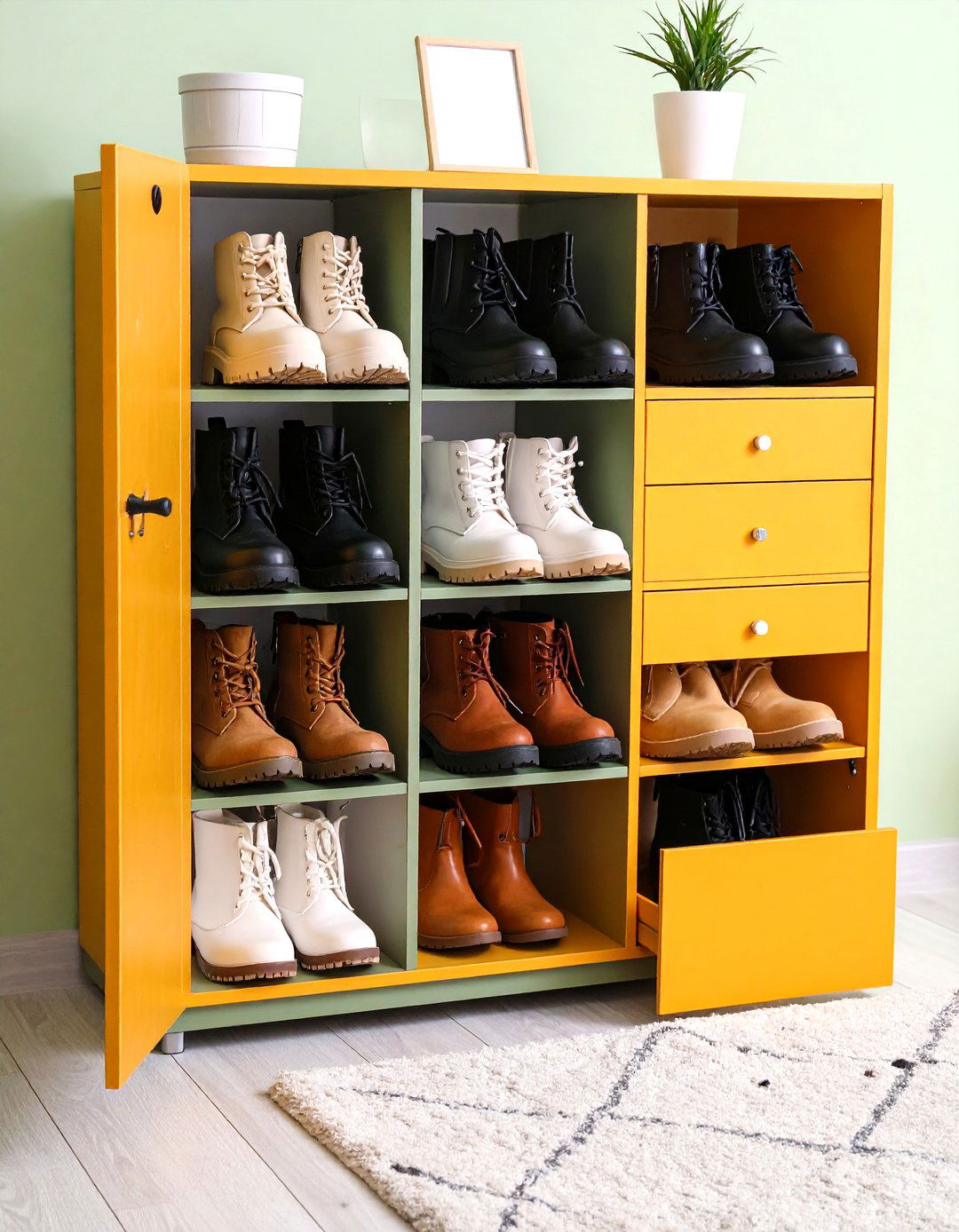
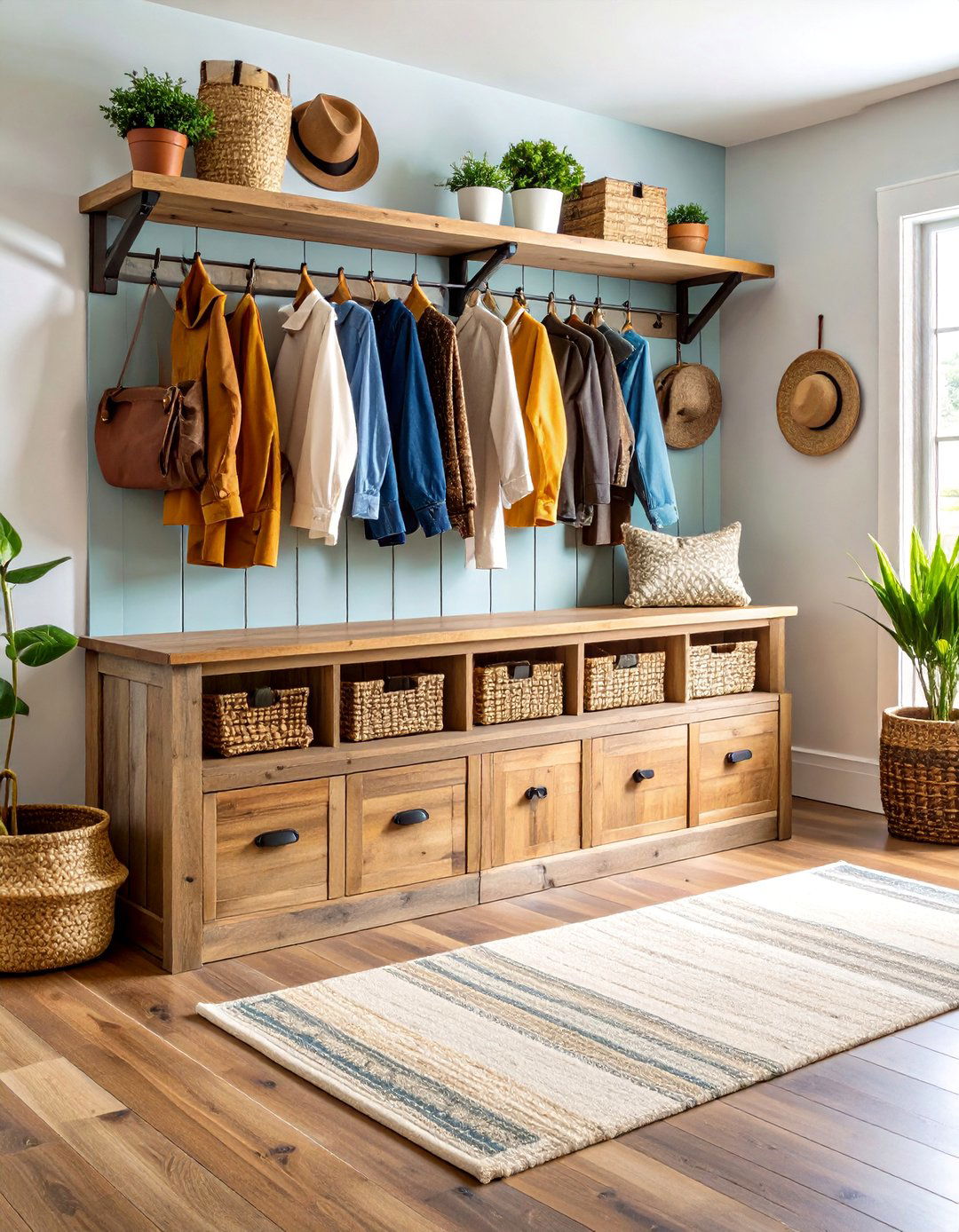
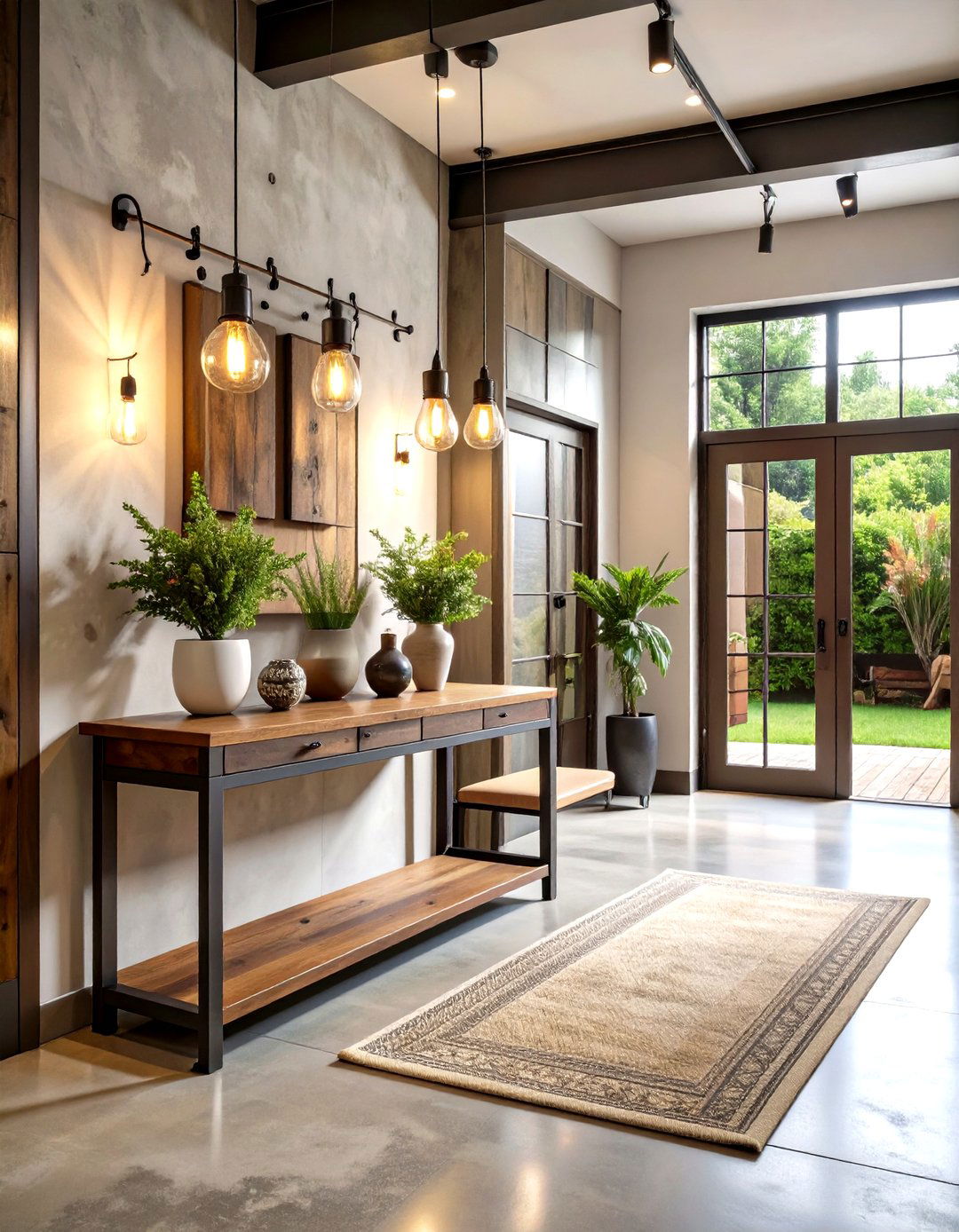
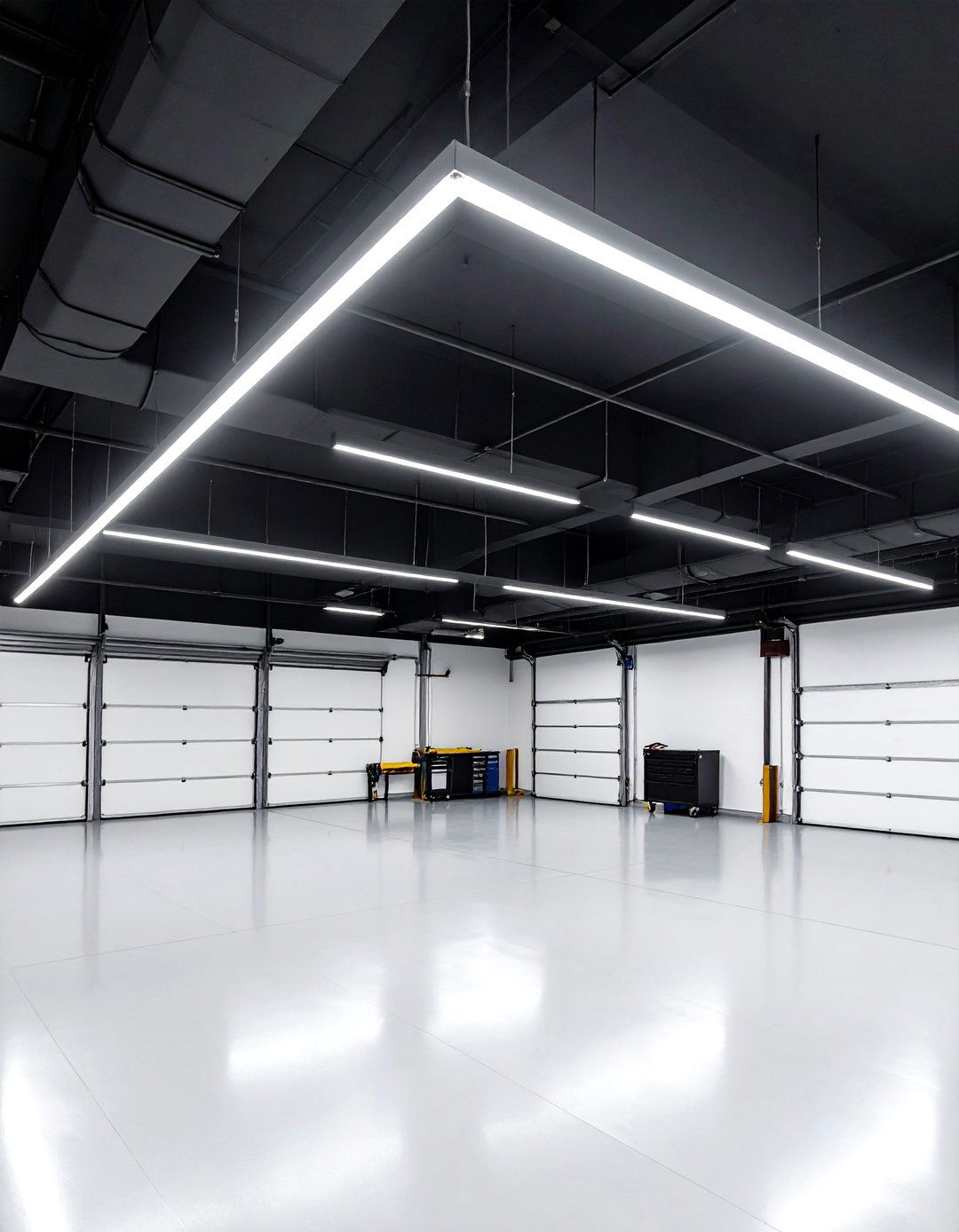
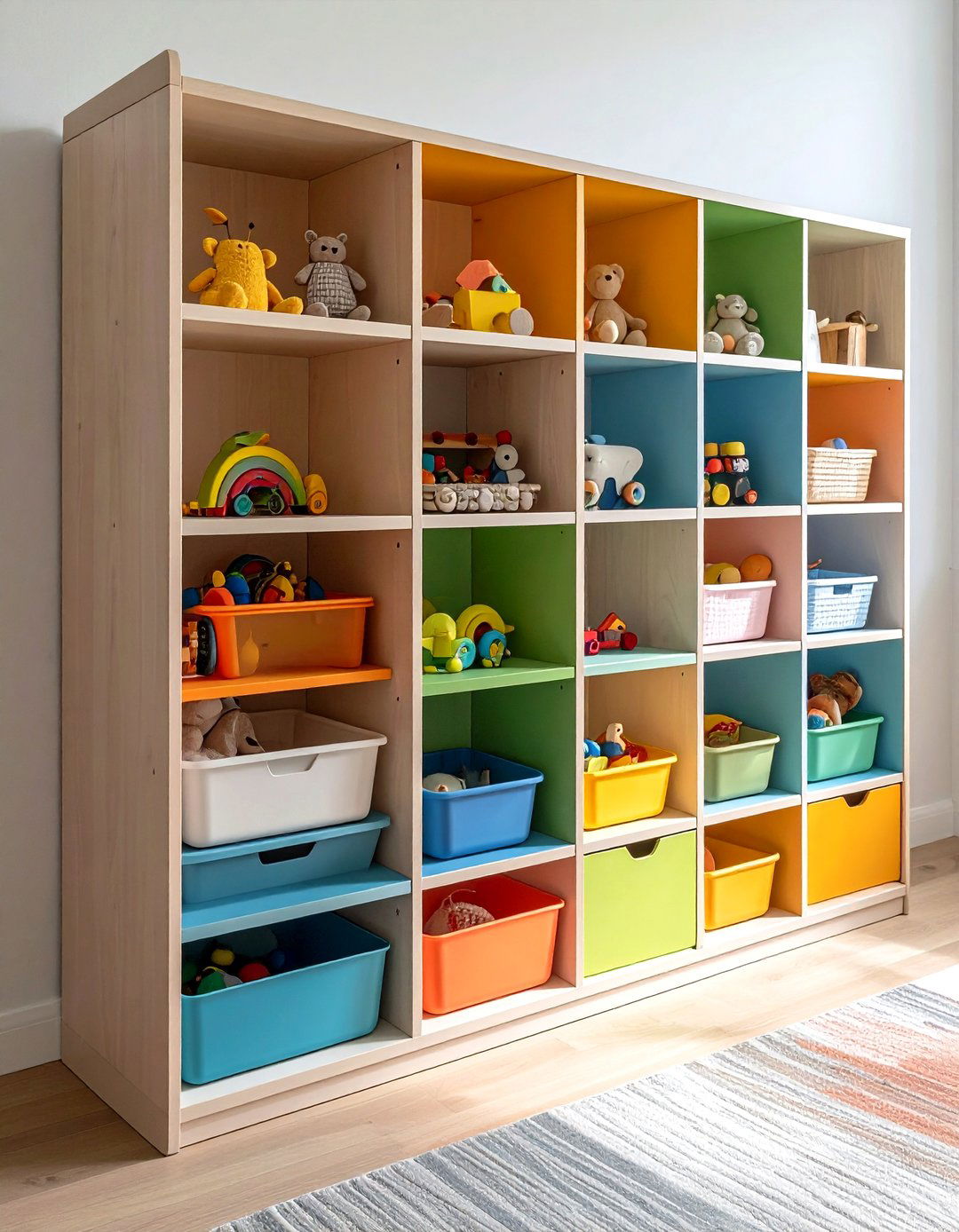
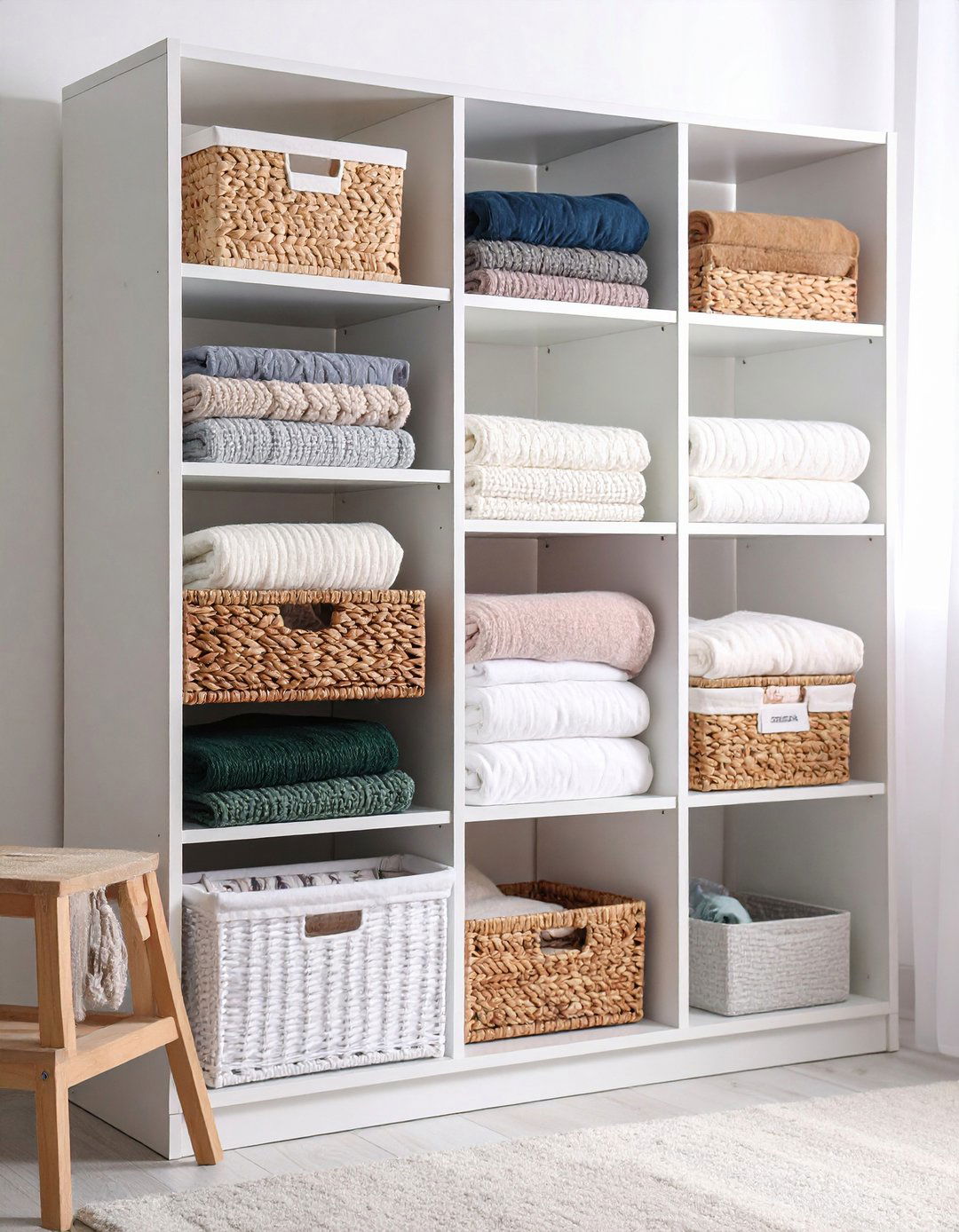

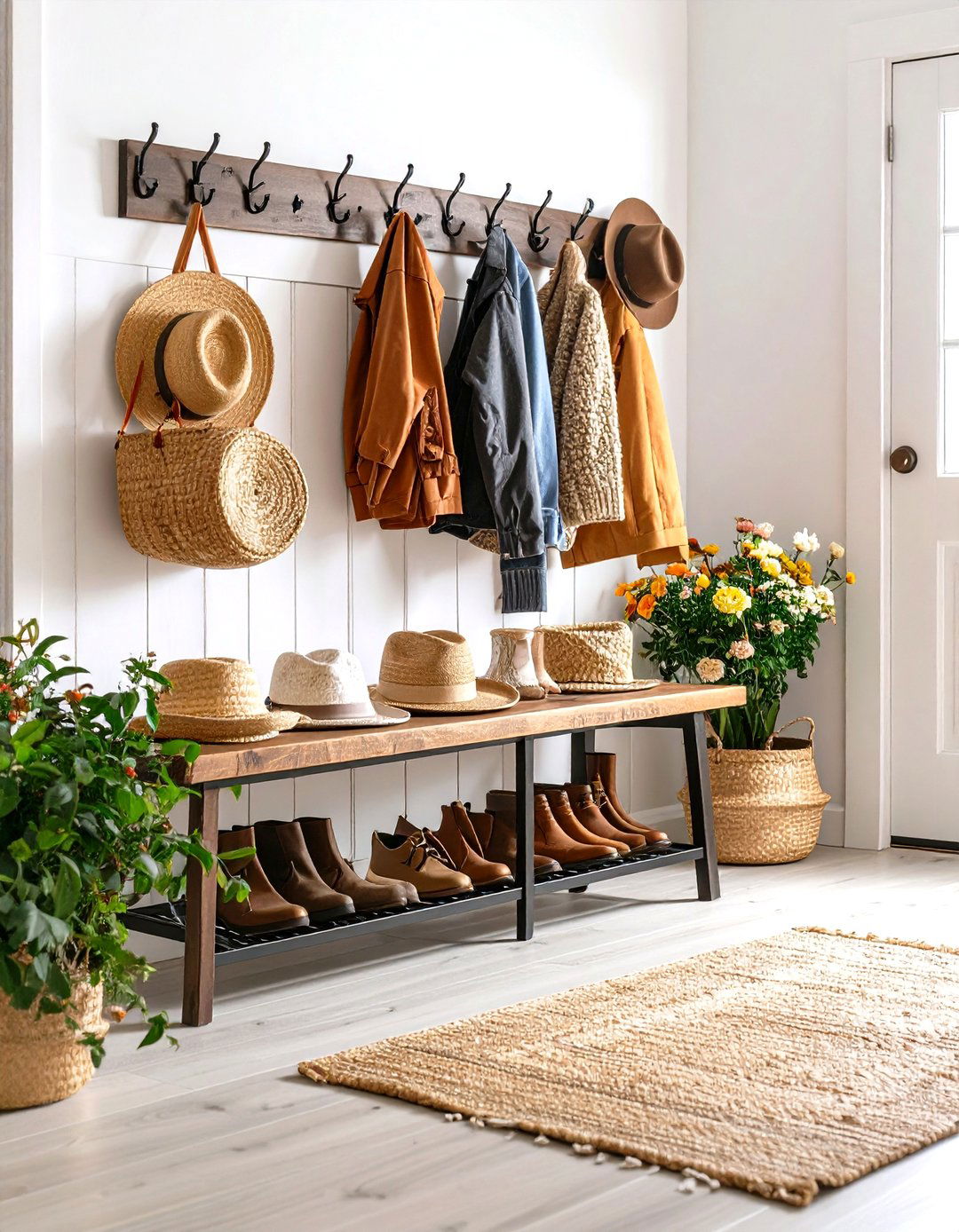
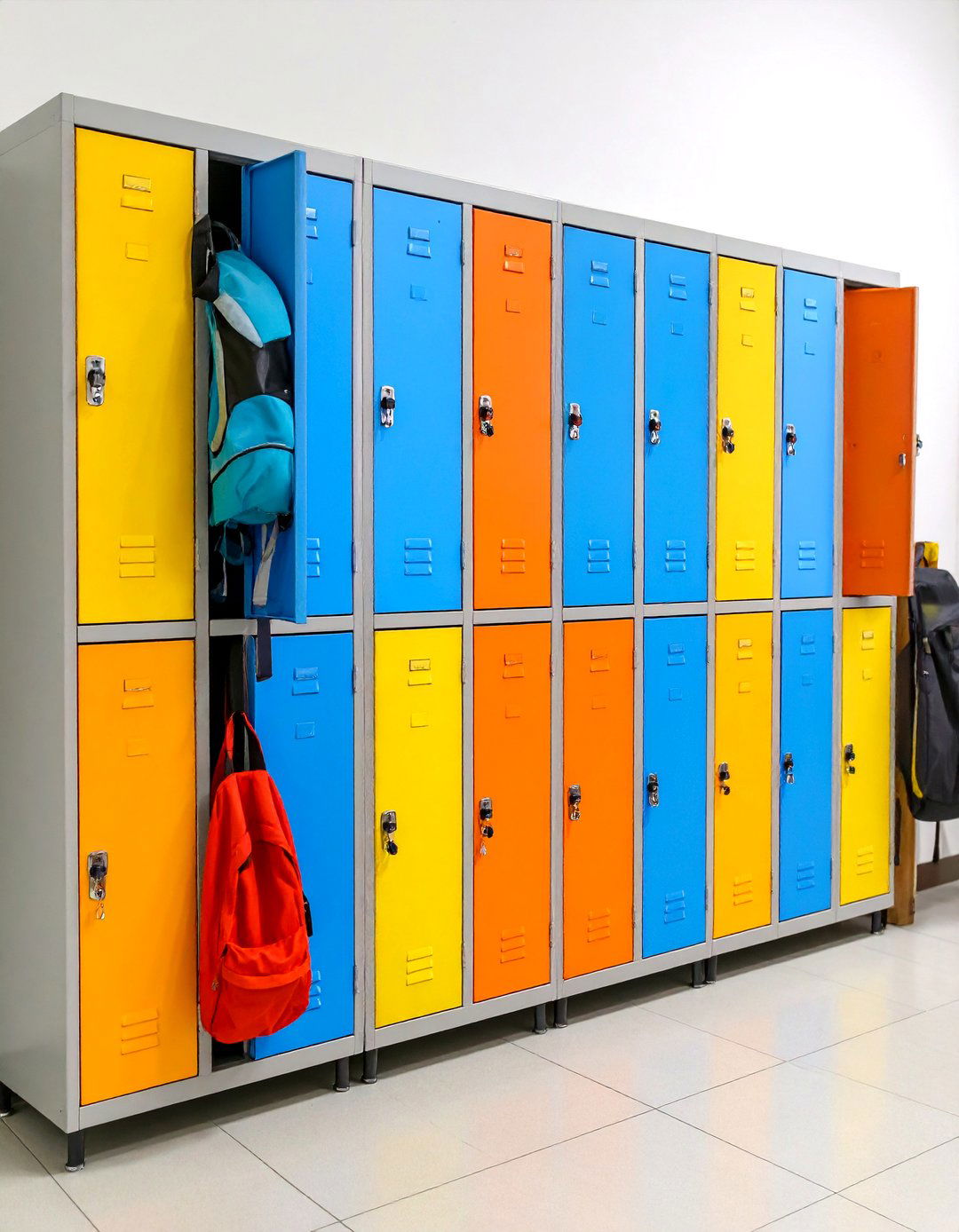


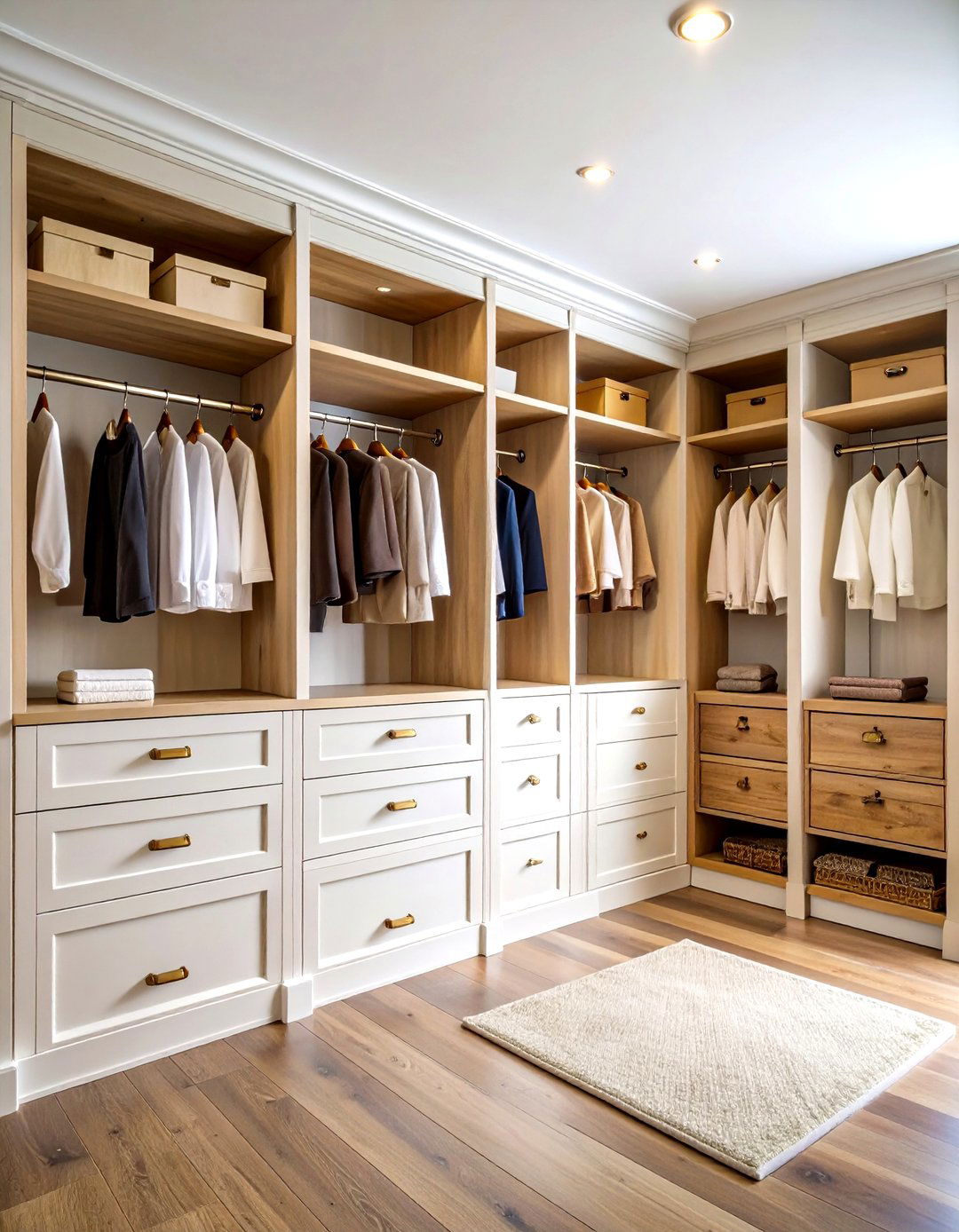
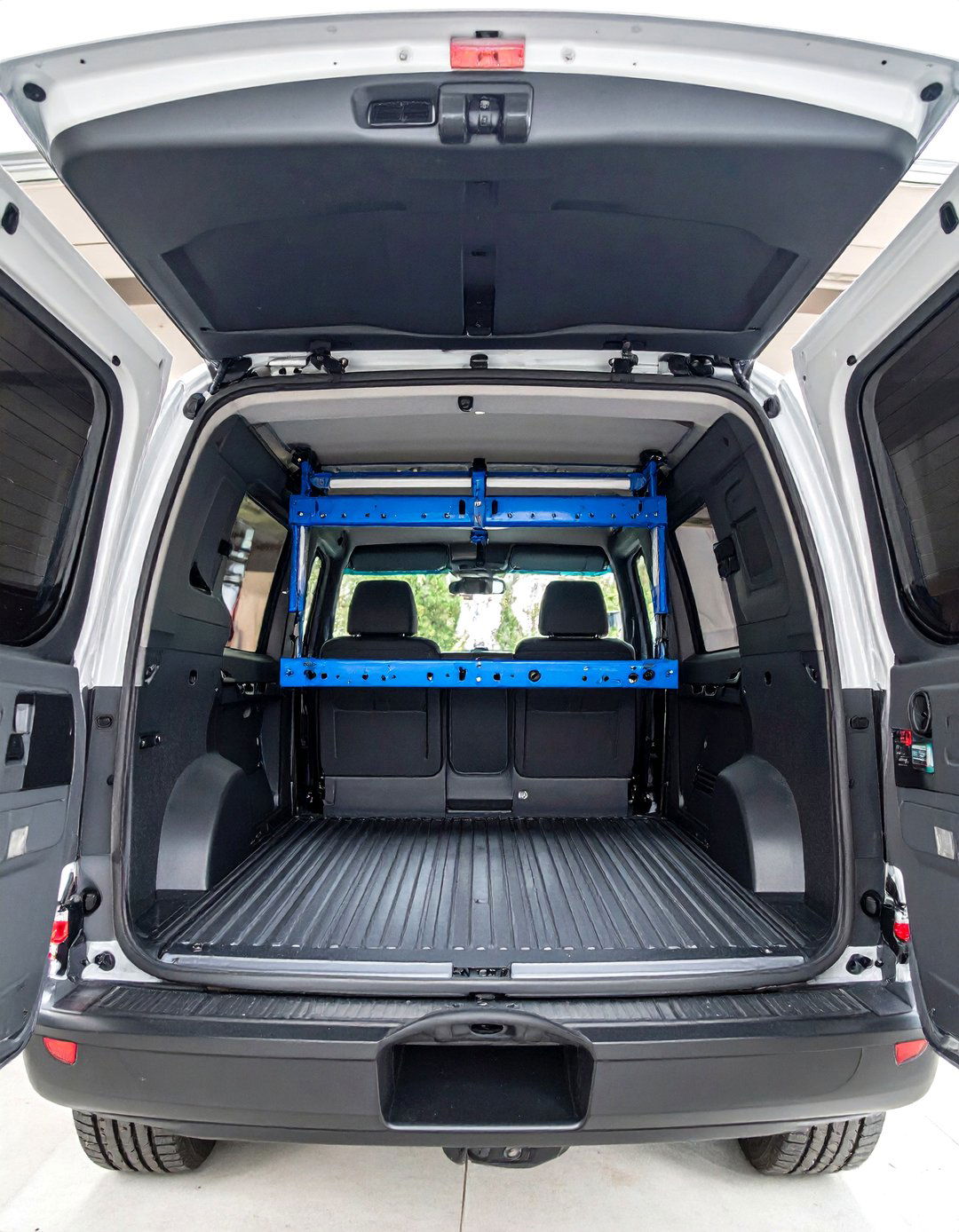
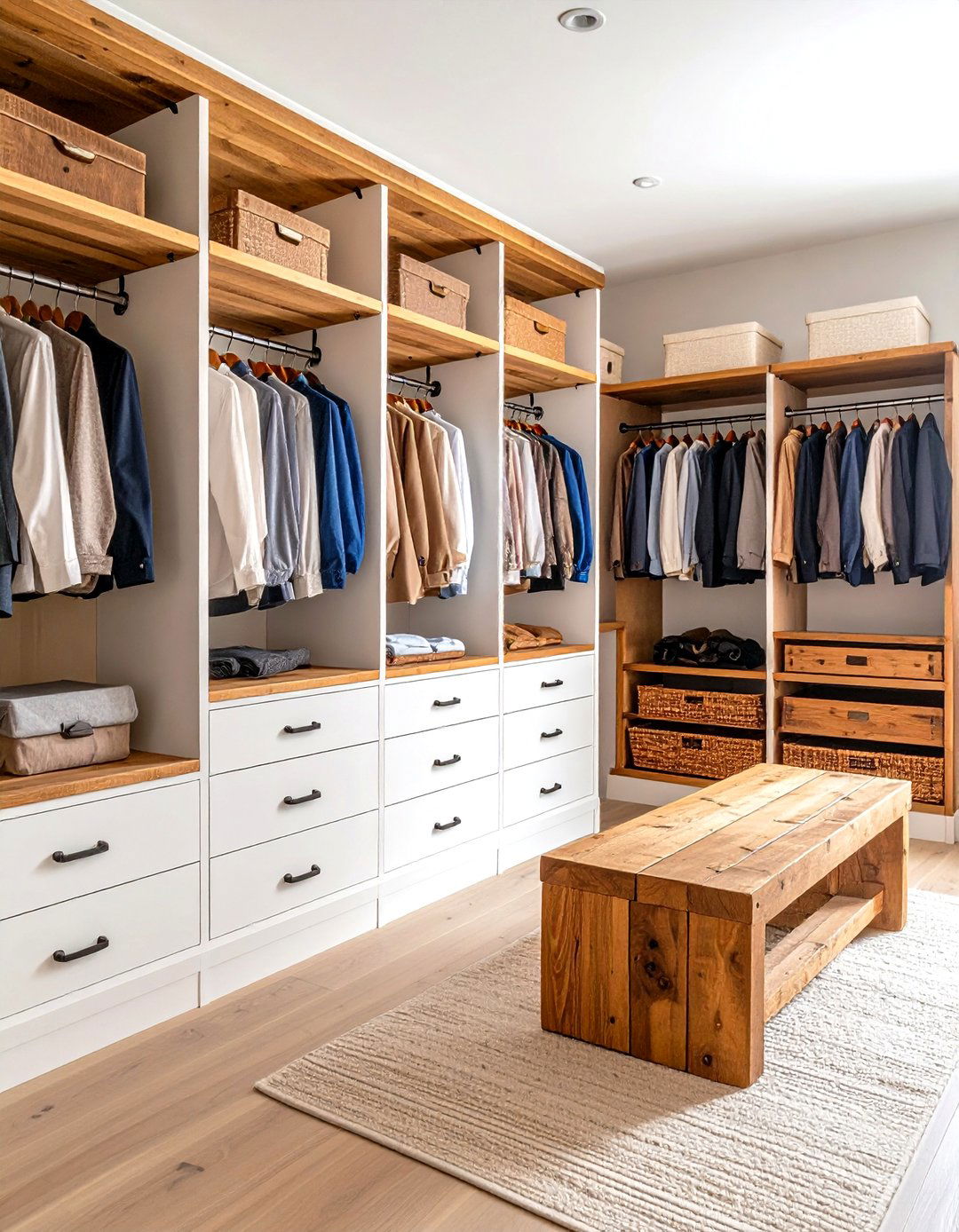
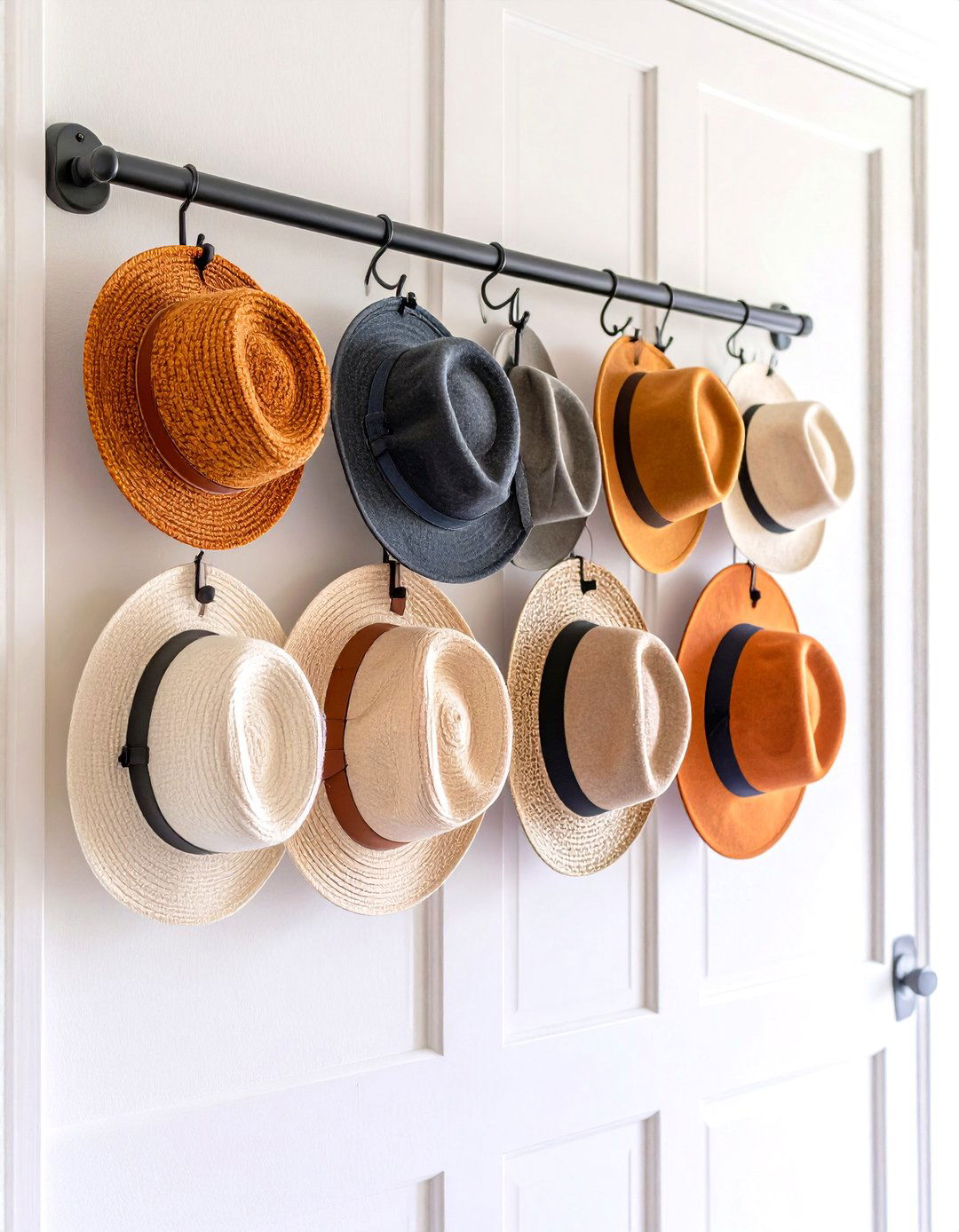
Leave a Reply